Paul van Yperen's Blog, page 396
January 1, 2015
Gaby Deslys
French dancer and actress Gaby Deslys (1881-1920) was an internationally celebrated - and notorious - star of the early 20th Century. She was famous for her extravagant clothes, jewels and millinery. 'The Charm of Paris' had many admirers, most notably King Manuel II of Portugal. And before her tragic, early death she also made a series of silent films.
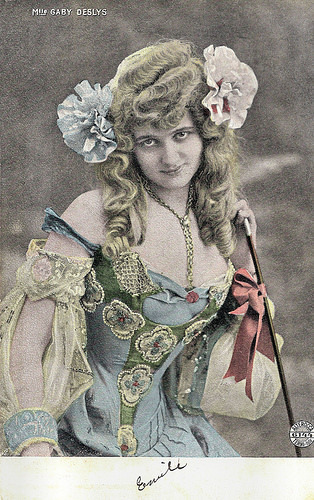
Italian postcard by Alterocca, Terni, no. 6144.
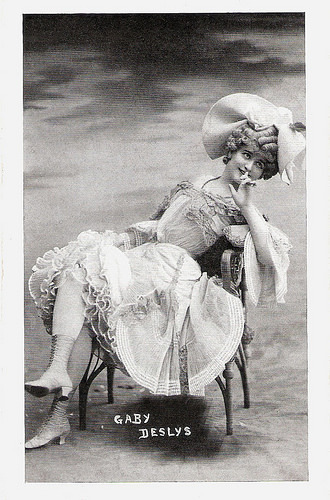
French postcard.
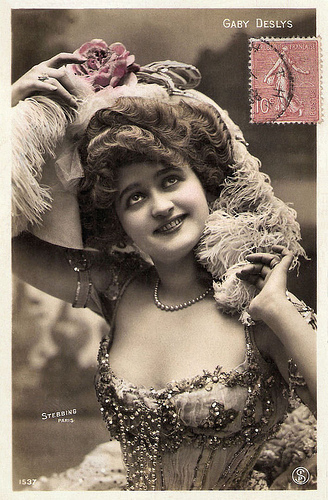
French postcard by SIP, no. 1537. Photo: Stebbing, Paris.
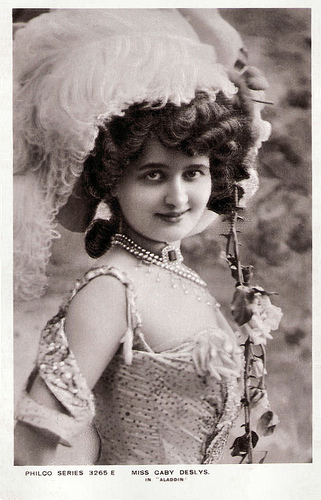
British postcard in the Philco Series, London, no. 3265 E. Photo: publicity still for The New Aladdin, produced at the Gaiety Theatre, London, in 1906. Gaby was 'The Charm of Paris'. The New Aladdin was produced by George Edwardes and ran for 203 performances.
The Ju-Jitsu Waltz
Gaby Deslys was born in the French harbour city Marseille as Marie-Elise Gabrielle Caire in 1881, but during the latter part of her life and after her death, this identification was put under scrutiny. (Wikipedia claims that she was Czech peasant girl, born in the village of Horní Moštěnice under the name of Hedvika Navratilova).
She selected the name Gaby Deslys for her stage career - an abbreviation of Gabrielle of the Lillies. She started her career in 1898 in the Folies Bergères in Paris. Gaby was dedicated to dancing, and loved to please the audiences.
In 1906 she travelled to London and appeared at the Gaiety Theatre in The New Aladdin and performed the Ju-Jitsu waltz. She was nicknamed 'The Charm of Paris'.
Deslys became an international celebrity following newspaper stories about King Manuel's infatuation with her. He is thought to have given Deslys a pearl necklace worth $70,000 after first meeting her in Paris in 1909. More gifts soon followed.
In 1911, she appeared on Broadway at the Winter Garden in Vera Violetta. In 1913 she starred in The Honeymoon Express which also featured Al Jolson (in blackface) and a young Mae West. Gaby’s costume gowns attained almost as much attention as she herself did. She is credited for introducing the first Striptease number in a Broadway Musical.
She returned to Paris with American dancer Henry (Harry) Pilcer, who she was rumoured to have been married to. Pilcer created her most famous dance, The Gaby Glide, which she performed in Europe and in the United States. They became the most popular dance couple of the music-halls of Paris.
With her ostrich feathers and sexy costumes, Gaby Deslys introduced a new style. She also introduced the first Jazzband to Paris: Alexander's Ragtime Band.
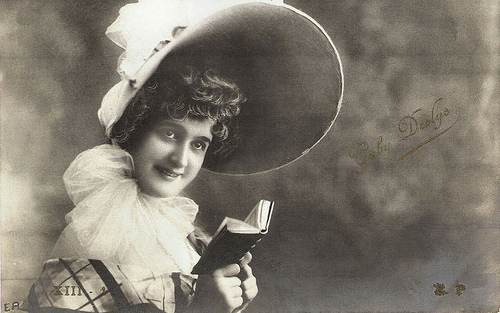
French postcard by E.P.
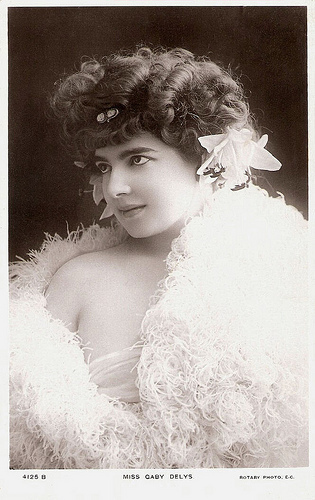
British postcard by Rotary Photo, no. 4125 B.
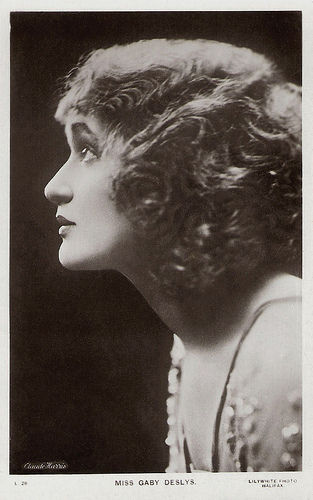
British postcard in the Lilywhite Photographic Series, Halifax, no. L 28. Photo: Claude Harris.
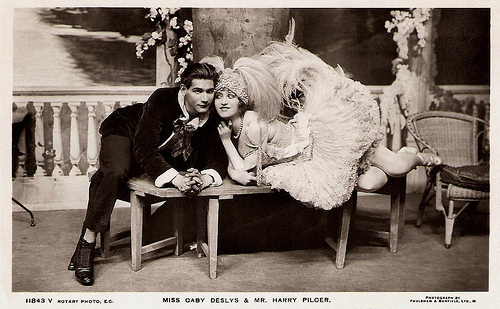
With Harry Pilcer. British postcard by Rotary Photo, no. 11843 V. Photo: Foulsham & Banfield.
Severe Throat Infection
In London Peter Pan author J.M. Barrie was so smitten by Gaby Deslys that he wrote a one-act play for her, Rosy Rapture, at the Duke of York's Theatre. This became also one of her first films, A Rosy Rapture (Percy Nash, 1914).
Deslys loved the camera and it loved her. From the beginning of her career she had posed for numerous still photographs. These stills, as with many other actresses, were sold as part of cigarette packages or after performance lobby cards aimed at patrons, usually male, who wanted a take home keepsake of their favourite performer.
Other short films followed like the French La Remplaçante/The Substitute (René Hervil, Louis Mercanton, 1914) with Jean Angelo . In 1915 Gaby Deslys and Harry Pilcer filmed for Famous Players Lasky in Paris Her Triumph (1915).
A feature film with the couple was Bouclette/Pincurl (René Hervil, Louis Mercanton, 1918), written by French avant-garde director Marcel L’Herbier who also co-starred.
In Dieu du hasard/God of the chance (Henri Pouctal, 1919) Gaby appeared with Félix Oudart, Georges Tréville and Harry Pilcer.
She graced the cover of Pictures and the Picturegoer magazine in 1915, and Erté did a serigraph painting of her.
On a number of occasions she appeared at the Grand Casino in Marseilles. Her final performance there was in 1919. Deslys contracted a severe throat infection caused by influenza. She was operated on multiple times in an effort to eradicate the infection, on two occasions without the use of an anaesthetic, but she died in Paris in February 1920 at the age of 38.
In her will she left her villa and all of her property, valued at half a million dollars, to the poor of Marseilles. Her carved and gilded bed, in the form of an enormous swan, was bought at an auction by the Universal Studios prop department, and was used in The Phantom of the Opera (1925) and in Sunset Boulevard (1950) as the bed of Norma Desmond.
Gaby Deslys was portrayed by Tamara Toumanova in Deep in My Heart (Stanley Donen, 1954).
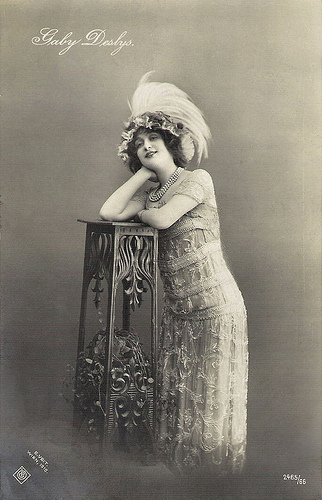
Austrian postcard by CP, no. 2465/66. Photo: E. Veit, Wien (Vienna), 1910.
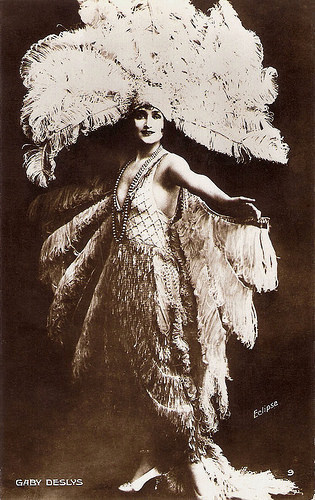
French postcard by Cinemagazine-Edition, no. 9. Photo: Eclipse.
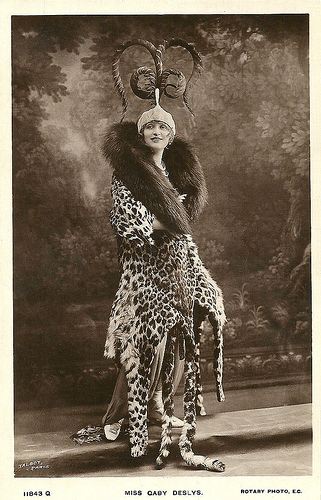
British postcard by Rotary Photo, no. 11843 Q. Photo: Talbot, Paris. Collection: Didier Hanson.
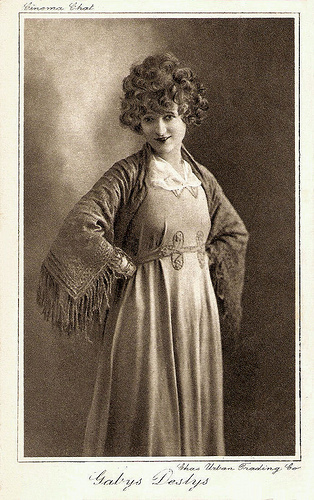
British postcard in the Cinema Chat series. Photo Chas Urban Trading co.
Sources: Wikipedia, Dance History Archives, National Portrait Gallery and .

Italian postcard by Alterocca, Terni, no. 6144.

French postcard.

French postcard by SIP, no. 1537. Photo: Stebbing, Paris.

British postcard in the Philco Series, London, no. 3265 E. Photo: publicity still for The New Aladdin, produced at the Gaiety Theatre, London, in 1906. Gaby was 'The Charm of Paris'. The New Aladdin was produced by George Edwardes and ran for 203 performances.
The Ju-Jitsu Waltz
Gaby Deslys was born in the French harbour city Marseille as Marie-Elise Gabrielle Caire in 1881, but during the latter part of her life and after her death, this identification was put under scrutiny. (Wikipedia claims that she was Czech peasant girl, born in the village of Horní Moštěnice under the name of Hedvika Navratilova).
She selected the name Gaby Deslys for her stage career - an abbreviation of Gabrielle of the Lillies. She started her career in 1898 in the Folies Bergères in Paris. Gaby was dedicated to dancing, and loved to please the audiences.
In 1906 she travelled to London and appeared at the Gaiety Theatre in The New Aladdin and performed the Ju-Jitsu waltz. She was nicknamed 'The Charm of Paris'.
Deslys became an international celebrity following newspaper stories about King Manuel's infatuation with her. He is thought to have given Deslys a pearl necklace worth $70,000 after first meeting her in Paris in 1909. More gifts soon followed.
In 1911, she appeared on Broadway at the Winter Garden in Vera Violetta. In 1913 she starred in The Honeymoon Express which also featured Al Jolson (in blackface) and a young Mae West. Gaby’s costume gowns attained almost as much attention as she herself did. She is credited for introducing the first Striptease number in a Broadway Musical.
She returned to Paris with American dancer Henry (Harry) Pilcer, who she was rumoured to have been married to. Pilcer created her most famous dance, The Gaby Glide, which she performed in Europe and in the United States. They became the most popular dance couple of the music-halls of Paris.
With her ostrich feathers and sexy costumes, Gaby Deslys introduced a new style. She also introduced the first Jazzband to Paris: Alexander's Ragtime Band.

French postcard by E.P.

British postcard by Rotary Photo, no. 4125 B.

British postcard in the Lilywhite Photographic Series, Halifax, no. L 28. Photo: Claude Harris.

With Harry Pilcer. British postcard by Rotary Photo, no. 11843 V. Photo: Foulsham & Banfield.
Severe Throat Infection
In London Peter Pan author J.M. Barrie was so smitten by Gaby Deslys that he wrote a one-act play for her, Rosy Rapture, at the Duke of York's Theatre. This became also one of her first films, A Rosy Rapture (Percy Nash, 1914).
Deslys loved the camera and it loved her. From the beginning of her career she had posed for numerous still photographs. These stills, as with many other actresses, were sold as part of cigarette packages or after performance lobby cards aimed at patrons, usually male, who wanted a take home keepsake of their favourite performer.
Other short films followed like the French La Remplaçante/The Substitute (René Hervil, Louis Mercanton, 1914) with Jean Angelo . In 1915 Gaby Deslys and Harry Pilcer filmed for Famous Players Lasky in Paris Her Triumph (1915).
A feature film with the couple was Bouclette/Pincurl (René Hervil, Louis Mercanton, 1918), written by French avant-garde director Marcel L’Herbier who also co-starred.
In Dieu du hasard/God of the chance (Henri Pouctal, 1919) Gaby appeared with Félix Oudart, Georges Tréville and Harry Pilcer.
She graced the cover of Pictures and the Picturegoer magazine in 1915, and Erté did a serigraph painting of her.
On a number of occasions she appeared at the Grand Casino in Marseilles. Her final performance there was in 1919. Deslys contracted a severe throat infection caused by influenza. She was operated on multiple times in an effort to eradicate the infection, on two occasions without the use of an anaesthetic, but she died in Paris in February 1920 at the age of 38.
In her will she left her villa and all of her property, valued at half a million dollars, to the poor of Marseilles. Her carved and gilded bed, in the form of an enormous swan, was bought at an auction by the Universal Studios prop department, and was used in The Phantom of the Opera (1925) and in Sunset Boulevard (1950) as the bed of Norma Desmond.
Gaby Deslys was portrayed by Tamara Toumanova in Deep in My Heart (Stanley Donen, 1954).

Austrian postcard by CP, no. 2465/66. Photo: E. Veit, Wien (Vienna), 1910.

French postcard by Cinemagazine-Edition, no. 9. Photo: Eclipse.

British postcard by Rotary Photo, no. 11843 Q. Photo: Talbot, Paris. Collection: Didier Hanson.

British postcard in the Cinema Chat series. Photo Chas Urban Trading co.
Sources: Wikipedia, Dance History Archives, National Portrait Gallery and .
Published on January 01, 2015 22:00
December 31, 2014
Roberto Benigni
Happy New Year! We start 2015 with Italy’s most popular film comedian since Totó, Roberto Benigni (1952). He worked with famous directors like Jim Jarmusch, Marco Ferreri, Bernardo Bertolucci, Federico Fellini, Wim Wenders, and Woody Allen. Benigni also directed several comedies himself, including the award winning La vita è bella/Life Is Beautiful (1997).
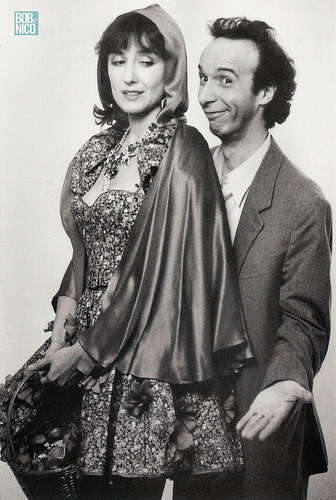
Italian postcard by Cineteca Bologna. Photo: Mimmo Cattarinich. Publicity still for Il Mostro/The Monster (Roberto Benigni, 1994) with Nicoletta Braschi.
Altar Boy
Roberto Remigio Benigni was born in Manciano La Misericordia, Italy, 1952 His parents were Luigi Benigni and Isolina Papini and he has three sisters. His father worked as a farmer, carpenter and bricklayer. He was a prisoner in the concentration camp Bergen-Belsen between 1943 and 1945. Roberto used his stories as the basis for his film La vita è bella (1997). His mother worked as a fabric inspector. Roberto was raised Catholic, served as an altar boy and attended a seminary in Florence, planning to become a priest.
In 1971, he moved to Rome where he took part in some experimental theatre shows, some of which he also directed. In 1975, Benigni had his first theatrical success with the play Cioni Mario di Gaspare fu Giulia (1975), written and directed by Giuseppe Bertolucci. Benigni played Mario Cioni, a character he later resumed in the variety TV series Onda Libera (Renzo Arbore, 1976). Benigni became famous in Italy when he interpreted in Onda Libera the satirical song L'inno del corpo sciolto (The Hymn of the Slippery Body), about the joys of defecation. It caused such a scandal that the censors suspended the series.
Benigni played Mario Cioni again in his first film, the comedy Berlinguer ti voglio bene/Berlinguer, I Love You (Giuseppe Bertolucci, 1977) with Alida Valli as his mother. The title quotes Benigni´s character´s declaration of love for Enrico Berlinguer, then leader of the Italian Communist Party. Later, Benigni appeared during a public political demonstration by the Italian Communist Party. On this occasion he lifted and cradled Berlinguer, normally a very serious figure. It was an unprecedented but very successful act, which lead politicians to exhibit a more popular behaviour from that moment on.
His popularity increased with L'altra domenica (1976-1979), another TV show in which Benigni portrays a lazy film critic who never watches the films he's asked to review. In 1979 he had an international success with the symbolic social drama Chiedo asilo/Seeking Asylum (Marco Ferreri, 1979) about a well-meaning teacher and his young pre-school class. The film was entered into the 30th Berlin International Film Festival where it won the Silver Bear - Special Jury Prize. Bernardo Bertolucci cast him in a small speechless role as a window upholsterer in La Luna/Luna (1979) starring Jill Clayburgh.
In 1980 Benigni met actress Nicoletta Braschi, who in 1991 became his wife. She co-starred in his first film as director, the comedy Tu mi turbi/You Upset Me (Roberto Benigni, 1983) and in most of his later films. Next, he played with the popular comic actor Massimo Troisi in Non ci resta che piangere/Nothing Left To Do But Cry (Roberto Benigni, Massimo Troisi, 1984). In this fable the two protagonists are suddenly thrown back in time to the 15th century, just a little before 1492. They start looking for Christopher Columbus in order to stop him from discovering the Americas (for very personal love reasons), but are not able to reach him.

Italian postcard by Cineteca Bologna. Photo: Mario Tursi. Publicity still for Il piccolo diavolo/The Little Devil (Roberto Benigni, 1988) with Nicoletta Braschi.
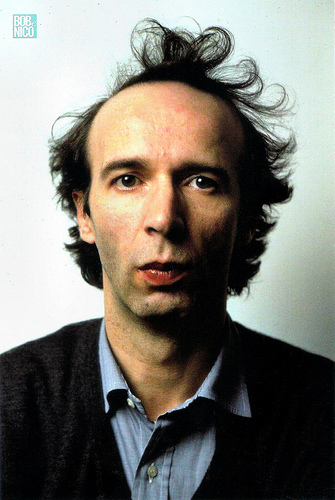
Italian postcard by Cineteca Bologna. Photo: Mimmo Catarinich.
Irrepressible good humour
Roberto Benigni was censored again in the 1980s for calling Pope John Paul II ‘Wojtylaccio’ during a TV show (‘Wojtylaccio’, translates as ‘Bad Wojtyla’, but with a friendly meaning in Tuscan dialect).
Benigni starred in three films by American director Jim Jarmusch. In Down By Law (Jim Jarmusch, 1986) he played Bob, an innocent foreigner living in the United States, convicted of manslaughter, whose irrepressible good humour and optimism help him to escape and find love. His co-stars were Tom Waits, John Lurie and Nicoletta Braschi, who of course played his beloved.
In Night on Earth (Jim Jarmusch, 1991) he played a cabbie in Rome, who causes his passenger, a priest (Paolo Bonacelli), great discomfort and a fatal heart attack by confessing his bizarre sexual experiences. He also starred in the first of Jarmusch's segments in Coffee and Cigarettes (2003).
In 1988 Benigni began a long-lasting collaboration with screenwriter Vincenzo Cerami. Their first film was Il piccolo diavolo/The Little Devil (Roberto Benigni, 1988) with Walter Matthau. For his part as the little devil, Benigni won the David di Donatello Award for Best Actor. It was the start of a series of comedies that were very popular in Italy, including Johnny Stecchino/Johnny Toothpick (Roberto Benigni, 1992), and Il mostro/The Monster (Roberto Benigni, Yves Attal, 1994). The box-office hit Johnny Stecchino, brought him considerable international attention.
Benigni had a rare serious role in Fellini's last film, La voce della luna/The Voice of the Moon (Federico Fellini, 1989). He also starred in Wim Wenders' Faraway, So Close (1993) and Son of the Pink Panther (Blake Edwards, 1993) as Inspector Clouseau's (Peter Sellers) illegitimate son who is assigned to save the Princess of Lugash. Also in this film are Panther regulars Herbert Lom , Burt Kwouk and a star of the original 1963 film, Claudia Cardinale . The film bombed in the US, but was a hit in Italy.
Outside his homeland, Benigni is probably best known for his tragicomedy La vita è bella/Life Is Beautiful (Roberto Benigni, 1997), also written by Vincenzo Cerami. The film is about an Italian Jewish man who tries to protect his son's innocence during his internment at a Nazi concentration camp, by telling him that the Holocaust is an elaborate game and he must adhere very carefully to the rules to win.
Benigni's father had spent three years in a concentration camp in Bergen-Belsen, and La vita è bella is based in part on his father's experiences. Although the story and presentation of the film had been discussed during production with different Jewish groups to limit the offense it might cause, critics accused the film of presenting the Holocaust without much suffering.
La vita è bella was shown at the 1998 Cannes Film Festival, and won the Grand Prix. In 1999 Benigni also won the Oscar for Best Actor. The score by Nicola Piovani won another Oscar for Best Original Dramatic Score, and the film was awarded the Oscar for Best Foreign Language Film. Famously, Benigni climbed over and then stood on the backs of the seats in front of him and applauded the audience before proceeding to the stage. And after winning his Best Actor Oscar, he said in his acceptance speech, "This is a terrible mistake because I used up all my English!" The film grossed worldwide more than $200 million.
He then appeared in the live-action film Astérix & Obélix contre César/Asterix and Obelix vs Caesar (Claude Zidi, 1999), based on Goscinny and Uderzo's Astérix comics and featuring Christian Clavier as Asterix and Gérard Depardieu as Obélix. Benigni played Lucius Detritus, a corrupt Roman provincial governor who wants to kill Julius Caesar.
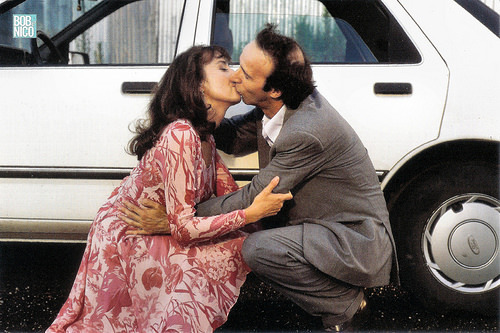
Italian postcard by Cineteca Bologna. Photo: Mimmo Cattarinich. Publicity still for Il Mostro/The Monster (Roberto Benigni, 1994) with Nicoletta Braschi.
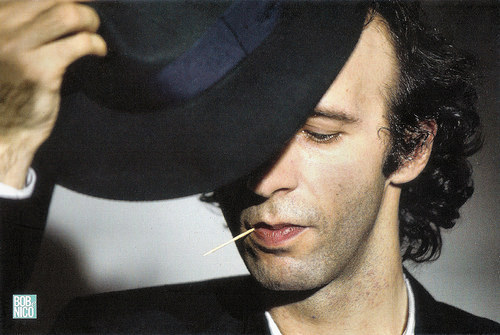
Italian postcard by Cineteca Bologna. Photo: Mimmo Catarinich.
Donatello and Raspberry Awards
Roberto Benigni’s next film, the live-action Pinocchio (Roberto Benigni, 2002) was one of the costliest films in Italian cinema ever. It performed well in Italy, but it bombed in North America. Pinocchio received six nominations at the David di Donatello Awards, winning two, as well as winning one of the two awards it was nominated for at the Italian National Syndicate of Film Journalists. At the 23rd Golden Raspberry Awards however, Benigni was named as the Worst Actor for his role as Pinocchio.
Benigni gave a typically energetic and revealing interview for Fellini: I'm a Born Liar (Damian Pettigrew, 2002), a cinematic portrait of the maestro that was nominated for Best Documentary at the European Film Awards.
His next film was La tigre e la neve/The Tiger and the Snow (Roberto Benigni, 2005) a romantic comedy set in contemporary Rome and in occupied Baghdad during the Iraq War.
In 2006 and 2007, Benigni toured Italy with his 90-minute one man show TuttoDante (Everything About Dante). Combining current events and memories of his past narrated with an ironic tone, Benigni then begins a journey of poetry and passion through the world of the Divine Comedy.
He performed TuttoDante during 130 shows in Italian piazzas, arenas, and stadiums for about one million spectators. Over 10 million more spectators watched the TV show, Il V canto dell’Inferno/The 5th Song of Hell (2007). In 2008-2009, Benigni brought TuttoDante to the United States and Canada.
His latest film appearance was in a segment of To Rome with Love (Woody Allen, 2012). Benigni played a man who wakes up one morning to discover that he has inexplicably become a national celebrity. To Rome with Love received mixed reviews but was a box office success.
Italian trailer for Il piccolo diavolo/The Little Devil (1988). Source: DionysusCinema (YouTube).
Trailer Il mostro/The Monster (1994). Source: GiuseppeDF (YouTube).
Italian trailer for Pinocchio (2002). Source: Gruppo Primavisione (YouTube).
Sources: Hal Erickson (AllMovie), Wikipedia and .

Italian postcard by Cineteca Bologna. Photo: Mimmo Cattarinich. Publicity still for Il Mostro/The Monster (Roberto Benigni, 1994) with Nicoletta Braschi.
Altar Boy
Roberto Remigio Benigni was born in Manciano La Misericordia, Italy, 1952 His parents were Luigi Benigni and Isolina Papini and he has three sisters. His father worked as a farmer, carpenter and bricklayer. He was a prisoner in the concentration camp Bergen-Belsen between 1943 and 1945. Roberto used his stories as the basis for his film La vita è bella (1997). His mother worked as a fabric inspector. Roberto was raised Catholic, served as an altar boy and attended a seminary in Florence, planning to become a priest.
In 1971, he moved to Rome where he took part in some experimental theatre shows, some of which he also directed. In 1975, Benigni had his first theatrical success with the play Cioni Mario di Gaspare fu Giulia (1975), written and directed by Giuseppe Bertolucci. Benigni played Mario Cioni, a character he later resumed in the variety TV series Onda Libera (Renzo Arbore, 1976). Benigni became famous in Italy when he interpreted in Onda Libera the satirical song L'inno del corpo sciolto (The Hymn of the Slippery Body), about the joys of defecation. It caused such a scandal that the censors suspended the series.
Benigni played Mario Cioni again in his first film, the comedy Berlinguer ti voglio bene/Berlinguer, I Love You (Giuseppe Bertolucci, 1977) with Alida Valli as his mother. The title quotes Benigni´s character´s declaration of love for Enrico Berlinguer, then leader of the Italian Communist Party. Later, Benigni appeared during a public political demonstration by the Italian Communist Party. On this occasion he lifted and cradled Berlinguer, normally a very serious figure. It was an unprecedented but very successful act, which lead politicians to exhibit a more popular behaviour from that moment on.
His popularity increased with L'altra domenica (1976-1979), another TV show in which Benigni portrays a lazy film critic who never watches the films he's asked to review. In 1979 he had an international success with the symbolic social drama Chiedo asilo/Seeking Asylum (Marco Ferreri, 1979) about a well-meaning teacher and his young pre-school class. The film was entered into the 30th Berlin International Film Festival where it won the Silver Bear - Special Jury Prize. Bernardo Bertolucci cast him in a small speechless role as a window upholsterer in La Luna/Luna (1979) starring Jill Clayburgh.
In 1980 Benigni met actress Nicoletta Braschi, who in 1991 became his wife. She co-starred in his first film as director, the comedy Tu mi turbi/You Upset Me (Roberto Benigni, 1983) and in most of his later films. Next, he played with the popular comic actor Massimo Troisi in Non ci resta che piangere/Nothing Left To Do But Cry (Roberto Benigni, Massimo Troisi, 1984). In this fable the two protagonists are suddenly thrown back in time to the 15th century, just a little before 1492. They start looking for Christopher Columbus in order to stop him from discovering the Americas (for very personal love reasons), but are not able to reach him.

Italian postcard by Cineteca Bologna. Photo: Mario Tursi. Publicity still for Il piccolo diavolo/The Little Devil (Roberto Benigni, 1988) with Nicoletta Braschi.

Italian postcard by Cineteca Bologna. Photo: Mimmo Catarinich.
Irrepressible good humour
Roberto Benigni was censored again in the 1980s for calling Pope John Paul II ‘Wojtylaccio’ during a TV show (‘Wojtylaccio’, translates as ‘Bad Wojtyla’, but with a friendly meaning in Tuscan dialect).
Benigni starred in three films by American director Jim Jarmusch. In Down By Law (Jim Jarmusch, 1986) he played Bob, an innocent foreigner living in the United States, convicted of manslaughter, whose irrepressible good humour and optimism help him to escape and find love. His co-stars were Tom Waits, John Lurie and Nicoletta Braschi, who of course played his beloved.
In Night on Earth (Jim Jarmusch, 1991) he played a cabbie in Rome, who causes his passenger, a priest (Paolo Bonacelli), great discomfort and a fatal heart attack by confessing his bizarre sexual experiences. He also starred in the first of Jarmusch's segments in Coffee and Cigarettes (2003).
In 1988 Benigni began a long-lasting collaboration with screenwriter Vincenzo Cerami. Their first film was Il piccolo diavolo/The Little Devil (Roberto Benigni, 1988) with Walter Matthau. For his part as the little devil, Benigni won the David di Donatello Award for Best Actor. It was the start of a series of comedies that were very popular in Italy, including Johnny Stecchino/Johnny Toothpick (Roberto Benigni, 1992), and Il mostro/The Monster (Roberto Benigni, Yves Attal, 1994). The box-office hit Johnny Stecchino, brought him considerable international attention.
Benigni had a rare serious role in Fellini's last film, La voce della luna/The Voice of the Moon (Federico Fellini, 1989). He also starred in Wim Wenders' Faraway, So Close (1993) and Son of the Pink Panther (Blake Edwards, 1993) as Inspector Clouseau's (Peter Sellers) illegitimate son who is assigned to save the Princess of Lugash. Also in this film are Panther regulars Herbert Lom , Burt Kwouk and a star of the original 1963 film, Claudia Cardinale . The film bombed in the US, but was a hit in Italy.
Outside his homeland, Benigni is probably best known for his tragicomedy La vita è bella/Life Is Beautiful (Roberto Benigni, 1997), also written by Vincenzo Cerami. The film is about an Italian Jewish man who tries to protect his son's innocence during his internment at a Nazi concentration camp, by telling him that the Holocaust is an elaborate game and he must adhere very carefully to the rules to win.
Benigni's father had spent three years in a concentration camp in Bergen-Belsen, and La vita è bella is based in part on his father's experiences. Although the story and presentation of the film had been discussed during production with different Jewish groups to limit the offense it might cause, critics accused the film of presenting the Holocaust without much suffering.
La vita è bella was shown at the 1998 Cannes Film Festival, and won the Grand Prix. In 1999 Benigni also won the Oscar for Best Actor. The score by Nicola Piovani won another Oscar for Best Original Dramatic Score, and the film was awarded the Oscar for Best Foreign Language Film. Famously, Benigni climbed over and then stood on the backs of the seats in front of him and applauded the audience before proceeding to the stage. And after winning his Best Actor Oscar, he said in his acceptance speech, "This is a terrible mistake because I used up all my English!" The film grossed worldwide more than $200 million.
He then appeared in the live-action film Astérix & Obélix contre César/Asterix and Obelix vs Caesar (Claude Zidi, 1999), based on Goscinny and Uderzo's Astérix comics and featuring Christian Clavier as Asterix and Gérard Depardieu as Obélix. Benigni played Lucius Detritus, a corrupt Roman provincial governor who wants to kill Julius Caesar.

Italian postcard by Cineteca Bologna. Photo: Mimmo Cattarinich. Publicity still for Il Mostro/The Monster (Roberto Benigni, 1994) with Nicoletta Braschi.

Italian postcard by Cineteca Bologna. Photo: Mimmo Catarinich.
Donatello and Raspberry Awards
Roberto Benigni’s next film, the live-action Pinocchio (Roberto Benigni, 2002) was one of the costliest films in Italian cinema ever. It performed well in Italy, but it bombed in North America. Pinocchio received six nominations at the David di Donatello Awards, winning two, as well as winning one of the two awards it was nominated for at the Italian National Syndicate of Film Journalists. At the 23rd Golden Raspberry Awards however, Benigni was named as the Worst Actor for his role as Pinocchio.
Benigni gave a typically energetic and revealing interview for Fellini: I'm a Born Liar (Damian Pettigrew, 2002), a cinematic portrait of the maestro that was nominated for Best Documentary at the European Film Awards.
His next film was La tigre e la neve/The Tiger and the Snow (Roberto Benigni, 2005) a romantic comedy set in contemporary Rome and in occupied Baghdad during the Iraq War.
In 2006 and 2007, Benigni toured Italy with his 90-minute one man show TuttoDante (Everything About Dante). Combining current events and memories of his past narrated with an ironic tone, Benigni then begins a journey of poetry and passion through the world of the Divine Comedy.
He performed TuttoDante during 130 shows in Italian piazzas, arenas, and stadiums for about one million spectators. Over 10 million more spectators watched the TV show, Il V canto dell’Inferno/The 5th Song of Hell (2007). In 2008-2009, Benigni brought TuttoDante to the United States and Canada.
His latest film appearance was in a segment of To Rome with Love (Woody Allen, 2012). Benigni played a man who wakes up one morning to discover that he has inexplicably become a national celebrity. To Rome with Love received mixed reviews but was a box office success.
Italian trailer for Il piccolo diavolo/The Little Devil (1988). Source: DionysusCinema (YouTube).
Trailer Il mostro/The Monster (1994). Source: GiuseppeDF (YouTube).
Italian trailer for Pinocchio (2002). Source: Gruppo Primavisione (YouTube).
Sources: Hal Erickson (AllMovie), Wikipedia and .
Published on December 31, 2014 22:00
December 30, 2014
Liselotte Pulver
Swiss actress Liselotte Pulver (1929) was one of the most beloved stars of the German popular cinema of the 1950s and early 1960s. Despite a wide variety of roles, she is best remembered as the merry tomboy in sparkling comedies like Das Wirtshaus im Spessart/The Spessart Inn (1958).
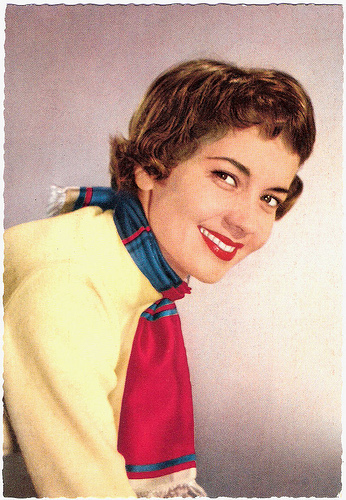
German postcard by ISV, no. E 16. Photo: Witt-Film / Constantin / Bokelberg.
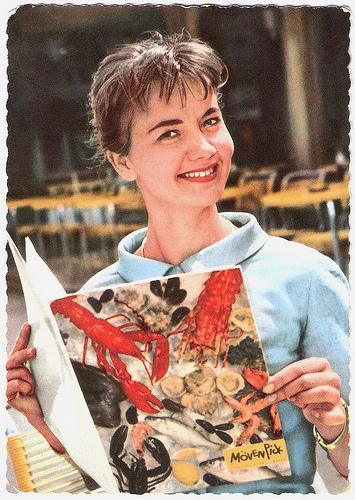
German postcard by UFA, no. CK-237. Retail price: 30 Pfg. Photo: Joe Niczky / Ufa. Collection: Egbert Barten.
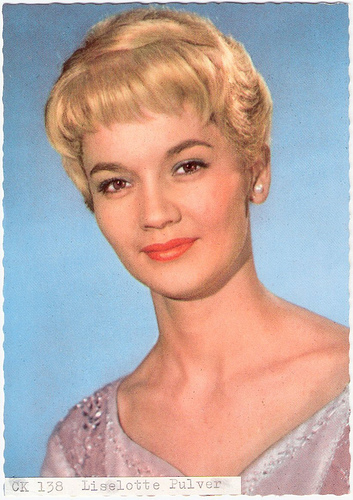
German postcard by Universum-Film Aktiengesellschaft (UFA), Berlin-Tempelhof, no. CK-138. Photo: Ringpress / Vogelmann.
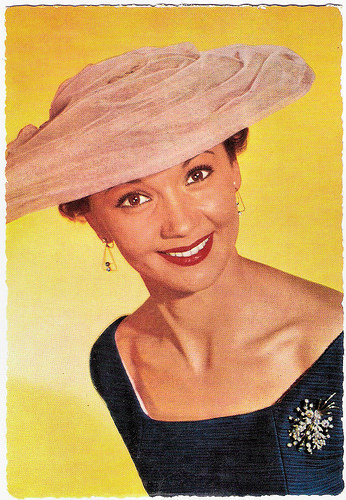
German postcard by WS-Druck, Wanne-Eickel, no. F. 15. Photo: Ringpress.

German postcard by WS-Druck, Wanne-Eickel, no. F 42. Photo: Collignon.
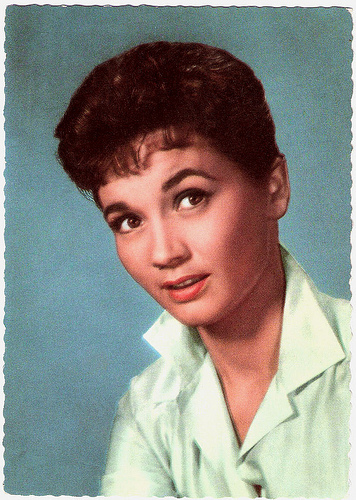
German postcard by Ufa, Berlin-Tempelhof, no. CK 166. Retail price: 30 Pfg. Photo: Universal-Film Inc.
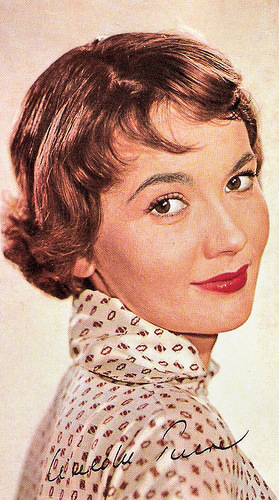
German collectors card by Lux.
First Box Office Hits
Liselotte (nicknamed Lilo) Pulver was born in Bern, Switzerland, in 1929. She was the youngest daughter of civil engineer Fritz Eugen Pulver and his wife Germaine. Her older sister was journalist Corinne Pulver.
From 1945 on Liselotte attended commercial school. After graduating in 1948, she started to work as a mannequin and took acting classes at the Berner Konservatorium (Bern conservatory). She made her stage debut at the Stadttheater Bern (Bern Theatre), and from 1949 to 1951 she appeared at the renowned Schauspielhaus Zurich.
Austrian film director Leopold Lindtberg cast the 20-year-old actress in his Swiss-American comedy Swiss Tour/Four Days Leave (Leopold Lindtberg, 1950) starring Cornel Wilde. After this debut, she inaugurated a long career in European films.
She first starred alongside Hans Albers in the mountain drama Föhn/White Hell (Rolf Hansen, 1950). Then she worked for the first time with director Kurt Hoffmann on the crime comedy Klettermaxe (1952). They would make 10 films together.
Her first box office hits were the Swiss film Uli der Knecht/Uli the Servant (Franz Schnyder, 1954) and its sequel Uli der Pächter/Uli the Tenant (Franz Schnyder, 1955).
Her breakthrough role was a Puszta school girl in Ich denke oft an Piroschka/I Often Think of Piroschka (Kurt Hoffmann, 1955). This Heimatfilm was not situated in Germany but in the Hungarian provinces, known as the Puszta. By focusing on the cultural differences between a German student on holidays and his Hungarian hosts as well as the student's unfamiliarity with rural life, Hoffmann created a sparkling comedy. Stephanie D'heil at Steffi-line writes that it made Pulver the German equivalent of Audrey Hepburn .
Another big hit was the fairy tale Das Wirtshaus im Spessart/The Spessart Inn (Kurt Hoffmann, 1958), in which she played a lovely countess who dresses up as a man to join a gang of robbers. The huge success of this film made her the prototype tomboy of the German cinema of the 1950s, with her hearty and joyful laughter as her trademark. Das Wirtshaus im Spessart inspired two sequels in 1960 and 1967, both directed by Hoffmann and starring Pulver.
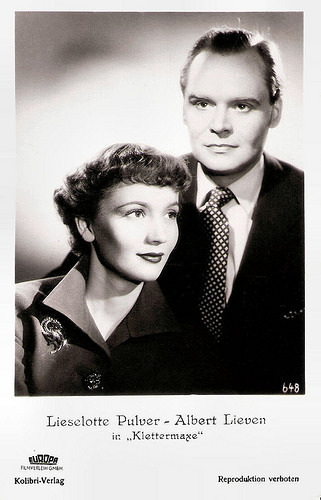
German postcard by Kolibri-Verlag, no. 648. Photo: Europa Filmverleih. Publicity still for Klettermaxe/Corry Bell (Kurt Hoffmann, 1952) with Albert Lieven .
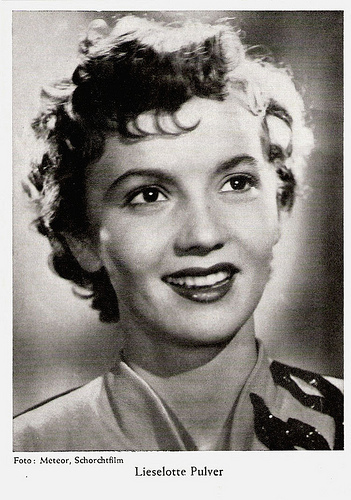
Belgian card. Photo: Meteor / Schorchtfilm.
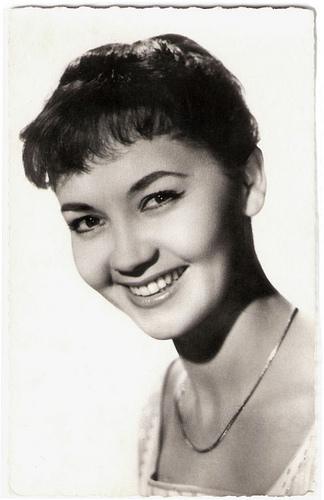
French postcard by Edition du Globe, Paris, no. 712. Photo: Sam Lévin.
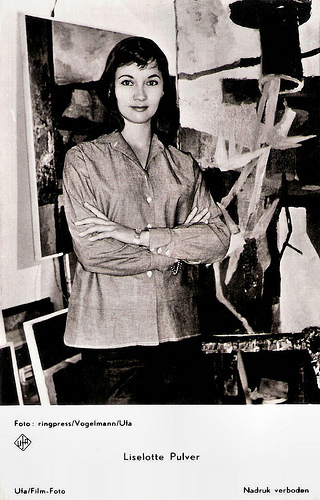
Dutch postcard by Gebr. Spanjersberg NV, Rotterdam, no. 4527. Photo: Ringpress / Vogelmann / Ufa.
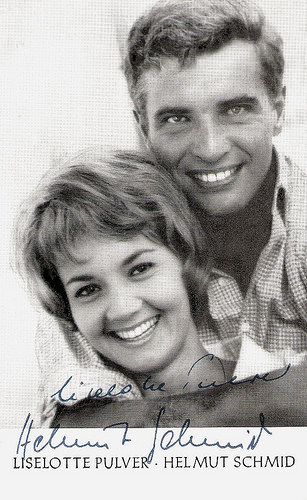
With husband Helmut Schmid. German postcard by Eduard Huber Verlag, Grünwald.
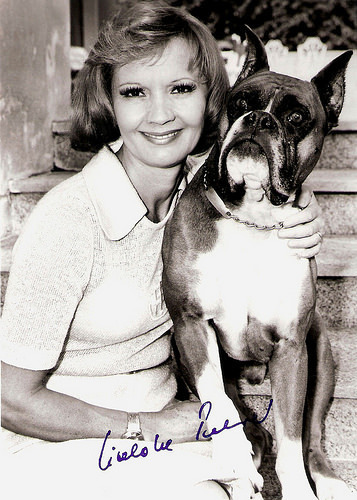
Swiss postcard by Linda Color, Genève. Photo: Erwin Schneider.
International Fame
Quickly Liselotte Pulver rose to international fame. She starred in the French crime film Les aventures d’Arsène Lupin/The Adventures of Arsène Lupin (Jacques Becker, 1957), as well as in the American Erich Maria Remarque adaptation A Time to Love and a Time to Die (Douglas Sirk, 1958).
Alongside French idol Gérard Philipe she starred in Le joueur/The Gambler (Claude Autant-Lara, 1958), an adaptation of Fyodor Dostoyevky's novel. She was considered to play leading roles in the Hollywood epics Ben-Hur (1959) and El Cid (1961), but she had already signed for other projects in Germany. She later said that this had been the biggest disappointment in her career.
In Germany, she starred in Die Zürcher Verlobung/The Affairs of Julie (Helmut Käutner, 1957), Das Glas Wasser/A Glass of Water (Helmut Käutner, 1960), and the Thomas Mann adaptations Bekenntnisse des Hochstaplers Felix Krull/Confessions of Felix Krull (Kurt Hoffmann, 1957) and Buddenbrooks (Alfred Weidenmann, 1959).
She proved her talent for slapstick in the comedy One, Two, Three (Billy Wilder, 1961). As busty, blonde Fraulein Ingeborg, the gum chewing secretary of philandering Coca-Cola executive James Cagney she was hilarious. For her role as a Russian woman in the Bob Hope comedy A Global Affair (Jack Arnold, 1963) she was nominated for the Golden Globe Award as best supporting actress. Artistically, her performance as a lesbian abbess in La Religieuse/The Nun (Jacques Rivette, 1966) became the highlight of her career.
In 1960, she had met Swiss actor Helmut Schmid on the set of Gustav Adolfs Page (Rolf Hansen, 1960), and they married the following year. The couple had two children, son Marc-Tell (1962) and daughter Melisande (1967).
More and more she focussed on television and she appeared in several TV-series. From 1977 to 1983, she co-hosted Sesamstrasse, the German version of Sesame Street. In 1980, she won the Filmband in Gold for her longtime achievements in the German cinema. Furthermore, she published her memories … wenn man trotzdem lacht (If one laughs nevertheless) (1990). There were some tragedies in her private life. Her daughter Melisande committed suicide in 1989, and her husband, Helmut Schmid, died in 1992 of a heart attack.
Her last film was the hit comedy Das Superweib/The Superwife (Sönke Wortmann, 1996) with Heiner Lauterbach. On TV she was last seen in a remake of her film Die Zürcher Verlobung/The Affairs of Julie (Stephan Meyer, 2007) with Christoph Waltz.
Nowadays Liselotte Pulver lives secluded in her mansion in Perroy, on the shores of Lake Geneva. She also has an apartment at the Burgerheim, a retirement home near Bern.
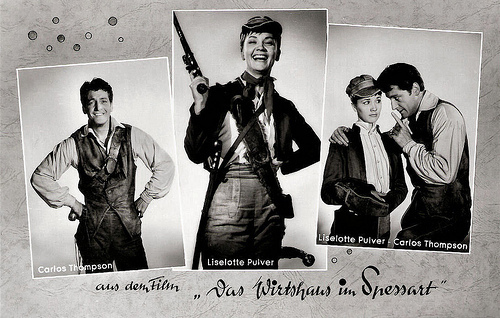
German postcard by Franz Josef Rüdel, Filmpostkartenverlag, Hamburg-Bergedorf, no. 2374. Photo: Witt / Constantin / Ringpress / Vogelmann. Publicity card for Das Wirtshaus im Spessart/The Spessart Inn (1958) with Carlos Thompson .
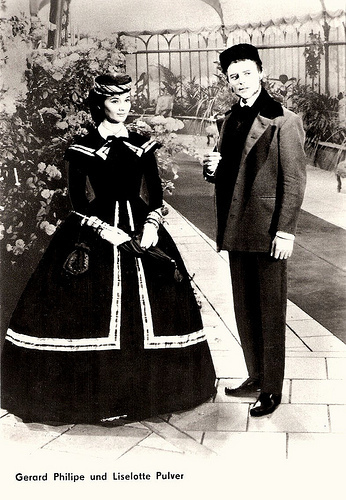
East-German postcard by VEB Progress Film-Vertrieb, no. 2699. Retail price: 0,20 MDN. Photo: publicity still for Le joueur/The Gambler (Claude Autant-Lara, 1958) with Gérard Philipe .
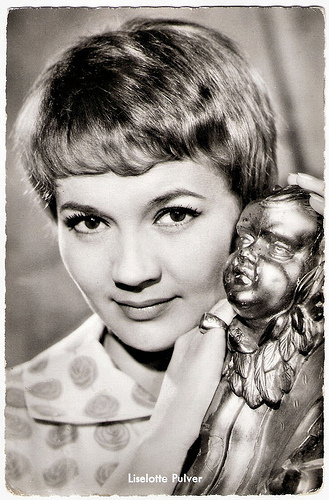
German postcard by Kolibri-Verlag G.m.b.H., Minden-Westf., no. 1389. Photo: Witt / Constantin / Grimm. Publicity still for Das Spukschloss im Spessart/The Haunted Caste (Kurt Hoffmann, 1960).

East-German postcard by VEB Progress Filmvertrieb, no. 1547, 1961. Photo: publicity still for Das Spukschloss im Spessart/The Haunted Castle (Kurt Hoffmann, 1960) with Georg Thomalla and Curt Bois.
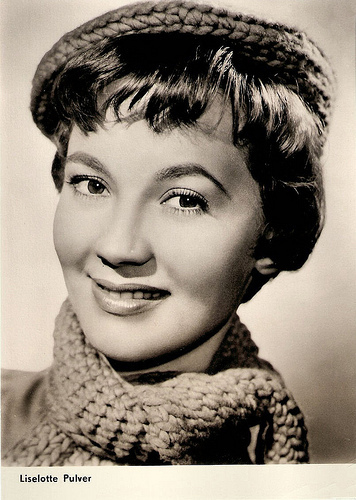
East-German postcard by VEB Progress Film-Vertrieb, Berlin, no. 2151, 1964. Retail price: 0,20 DM. Photo: Progress.
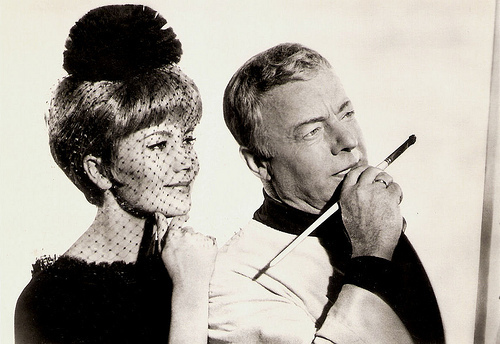
East-German postcard by VEB Progress Film-Vertrieb, Berlin, no. 2662, 1966. Retail price: 0,20 DM. Photo: Progress. Publicity still for Hokuspokus oder: Wie lasse ich meinen Mann verschwinden...?/Hocuspocus (Kurt Hoffmann, 1966) with Heinz Rühmann .
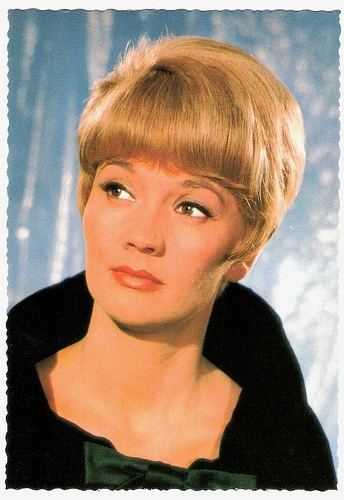
German postcard by ISV, no. E 37. Photo: Constantin. Publicity still for Hokuspokus oder: Wie lasse ich meinen Mann verschwinden...?/Hocuspocus (Kurt Hoffmann, 1966).
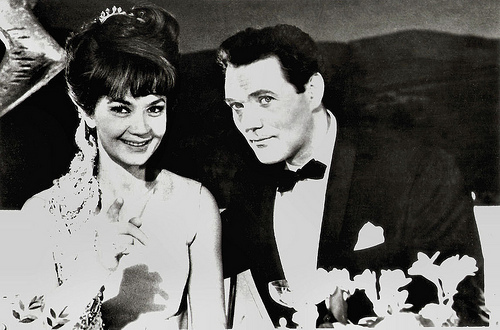
Romanian postcard by Casa Filmului Acin, no. 368. Photo: publicity still for Herrliche Zeiten im Spessart/Glorious Times in the Spessart (Kurt Hoffmann, 1967) with Harald Leipnitz.
Scene from Das Wirtshaus im Spessart/The Spessart Inn (1958). Source: Klarinettenqueen (YouTube).
Sources: Stephanie D'heil (Steffi-line) (German), Hal Erickson (AllMovie), Filmportal.de, Wikipedia and .

German postcard by ISV, no. E 16. Photo: Witt-Film / Constantin / Bokelberg.

German postcard by UFA, no. CK-237. Retail price: 30 Pfg. Photo: Joe Niczky / Ufa. Collection: Egbert Barten.

German postcard by Universum-Film Aktiengesellschaft (UFA), Berlin-Tempelhof, no. CK-138. Photo: Ringpress / Vogelmann.

German postcard by WS-Druck, Wanne-Eickel, no. F. 15. Photo: Ringpress.

German postcard by WS-Druck, Wanne-Eickel, no. F 42. Photo: Collignon.

German postcard by Ufa, Berlin-Tempelhof, no. CK 166. Retail price: 30 Pfg. Photo: Universal-Film Inc.

German collectors card by Lux.
First Box Office Hits
Liselotte (nicknamed Lilo) Pulver was born in Bern, Switzerland, in 1929. She was the youngest daughter of civil engineer Fritz Eugen Pulver and his wife Germaine. Her older sister was journalist Corinne Pulver.
From 1945 on Liselotte attended commercial school. After graduating in 1948, she started to work as a mannequin and took acting classes at the Berner Konservatorium (Bern conservatory). She made her stage debut at the Stadttheater Bern (Bern Theatre), and from 1949 to 1951 she appeared at the renowned Schauspielhaus Zurich.
Austrian film director Leopold Lindtberg cast the 20-year-old actress in his Swiss-American comedy Swiss Tour/Four Days Leave (Leopold Lindtberg, 1950) starring Cornel Wilde. After this debut, she inaugurated a long career in European films.
She first starred alongside Hans Albers in the mountain drama Föhn/White Hell (Rolf Hansen, 1950). Then she worked for the first time with director Kurt Hoffmann on the crime comedy Klettermaxe (1952). They would make 10 films together.
Her first box office hits were the Swiss film Uli der Knecht/Uli the Servant (Franz Schnyder, 1954) and its sequel Uli der Pächter/Uli the Tenant (Franz Schnyder, 1955).
Her breakthrough role was a Puszta school girl in Ich denke oft an Piroschka/I Often Think of Piroschka (Kurt Hoffmann, 1955). This Heimatfilm was not situated in Germany but in the Hungarian provinces, known as the Puszta. By focusing on the cultural differences between a German student on holidays and his Hungarian hosts as well as the student's unfamiliarity with rural life, Hoffmann created a sparkling comedy. Stephanie D'heil at Steffi-line writes that it made Pulver the German equivalent of Audrey Hepburn .
Another big hit was the fairy tale Das Wirtshaus im Spessart/The Spessart Inn (Kurt Hoffmann, 1958), in which she played a lovely countess who dresses up as a man to join a gang of robbers. The huge success of this film made her the prototype tomboy of the German cinema of the 1950s, with her hearty and joyful laughter as her trademark. Das Wirtshaus im Spessart inspired two sequels in 1960 and 1967, both directed by Hoffmann and starring Pulver.

German postcard by Kolibri-Verlag, no. 648. Photo: Europa Filmverleih. Publicity still for Klettermaxe/Corry Bell (Kurt Hoffmann, 1952) with Albert Lieven .

Belgian card. Photo: Meteor / Schorchtfilm.

French postcard by Edition du Globe, Paris, no. 712. Photo: Sam Lévin.

Dutch postcard by Gebr. Spanjersberg NV, Rotterdam, no. 4527. Photo: Ringpress / Vogelmann / Ufa.

With husband Helmut Schmid. German postcard by Eduard Huber Verlag, Grünwald.

Swiss postcard by Linda Color, Genève. Photo: Erwin Schneider.
International Fame
Quickly Liselotte Pulver rose to international fame. She starred in the French crime film Les aventures d’Arsène Lupin/The Adventures of Arsène Lupin (Jacques Becker, 1957), as well as in the American Erich Maria Remarque adaptation A Time to Love and a Time to Die (Douglas Sirk, 1958).
Alongside French idol Gérard Philipe she starred in Le joueur/The Gambler (Claude Autant-Lara, 1958), an adaptation of Fyodor Dostoyevky's novel. She was considered to play leading roles in the Hollywood epics Ben-Hur (1959) and El Cid (1961), but she had already signed for other projects in Germany. She later said that this had been the biggest disappointment in her career.
In Germany, she starred in Die Zürcher Verlobung/The Affairs of Julie (Helmut Käutner, 1957), Das Glas Wasser/A Glass of Water (Helmut Käutner, 1960), and the Thomas Mann adaptations Bekenntnisse des Hochstaplers Felix Krull/Confessions of Felix Krull (Kurt Hoffmann, 1957) and Buddenbrooks (Alfred Weidenmann, 1959).
She proved her talent for slapstick in the comedy One, Two, Three (Billy Wilder, 1961). As busty, blonde Fraulein Ingeborg, the gum chewing secretary of philandering Coca-Cola executive James Cagney she was hilarious. For her role as a Russian woman in the Bob Hope comedy A Global Affair (Jack Arnold, 1963) she was nominated for the Golden Globe Award as best supporting actress. Artistically, her performance as a lesbian abbess in La Religieuse/The Nun (Jacques Rivette, 1966) became the highlight of her career.
In 1960, she had met Swiss actor Helmut Schmid on the set of Gustav Adolfs Page (Rolf Hansen, 1960), and they married the following year. The couple had two children, son Marc-Tell (1962) and daughter Melisande (1967).
More and more she focussed on television and she appeared in several TV-series. From 1977 to 1983, she co-hosted Sesamstrasse, the German version of Sesame Street. In 1980, she won the Filmband in Gold for her longtime achievements in the German cinema. Furthermore, she published her memories … wenn man trotzdem lacht (If one laughs nevertheless) (1990). There were some tragedies in her private life. Her daughter Melisande committed suicide in 1989, and her husband, Helmut Schmid, died in 1992 of a heart attack.
Her last film was the hit comedy Das Superweib/The Superwife (Sönke Wortmann, 1996) with Heiner Lauterbach. On TV she was last seen in a remake of her film Die Zürcher Verlobung/The Affairs of Julie (Stephan Meyer, 2007) with Christoph Waltz.
Nowadays Liselotte Pulver lives secluded in her mansion in Perroy, on the shores of Lake Geneva. She also has an apartment at the Burgerheim, a retirement home near Bern.

German postcard by Franz Josef Rüdel, Filmpostkartenverlag, Hamburg-Bergedorf, no. 2374. Photo: Witt / Constantin / Ringpress / Vogelmann. Publicity card for Das Wirtshaus im Spessart/The Spessart Inn (1958) with Carlos Thompson .

East-German postcard by VEB Progress Film-Vertrieb, no. 2699. Retail price: 0,20 MDN. Photo: publicity still for Le joueur/The Gambler (Claude Autant-Lara, 1958) with Gérard Philipe .

German postcard by Kolibri-Verlag G.m.b.H., Minden-Westf., no. 1389. Photo: Witt / Constantin / Grimm. Publicity still for Das Spukschloss im Spessart/The Haunted Caste (Kurt Hoffmann, 1960).

East-German postcard by VEB Progress Filmvertrieb, no. 1547, 1961. Photo: publicity still for Das Spukschloss im Spessart/The Haunted Castle (Kurt Hoffmann, 1960) with Georg Thomalla and Curt Bois.

East-German postcard by VEB Progress Film-Vertrieb, Berlin, no. 2151, 1964. Retail price: 0,20 DM. Photo: Progress.

East-German postcard by VEB Progress Film-Vertrieb, Berlin, no. 2662, 1966. Retail price: 0,20 DM. Photo: Progress. Publicity still for Hokuspokus oder: Wie lasse ich meinen Mann verschwinden...?/Hocuspocus (Kurt Hoffmann, 1966) with Heinz Rühmann .

German postcard by ISV, no. E 37. Photo: Constantin. Publicity still for Hokuspokus oder: Wie lasse ich meinen Mann verschwinden...?/Hocuspocus (Kurt Hoffmann, 1966).

Romanian postcard by Casa Filmului Acin, no. 368. Photo: publicity still for Herrliche Zeiten im Spessart/Glorious Times in the Spessart (Kurt Hoffmann, 1967) with Harald Leipnitz.
Scene from Das Wirtshaus im Spessart/The Spessart Inn (1958). Source: Klarinettenqueen (YouTube).
Sources: Stephanie D'heil (Steffi-line) (German), Hal Erickson (AllMovie), Filmportal.de, Wikipedia and .
Published on December 30, 2014 22:00
December 29, 2014
Anna Magnani
Passionate, fearless, and exciting Anna Magnani (1908-1973) was the ‘volcano’ of the Italian cinema. The unkempt, earthy actress radiated such fierce intelligence and sensuality that she became a major star with Rossellini's Roma, città aperta/Rome, Open City (1945), and won an Oscar for her portrayal of a Sicilian widow in The Rose Tattoo (1955). She also gave dynamic and forceful portrayals of working-class women in Il miracolo/The Miracle (1948), Bellissima (1951), and Mamma Roma (1962).
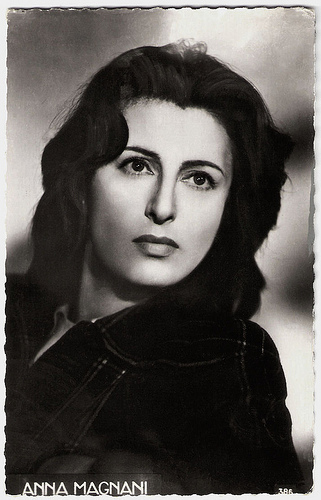
French postcard by Editions P.I., Paris, no. 386.
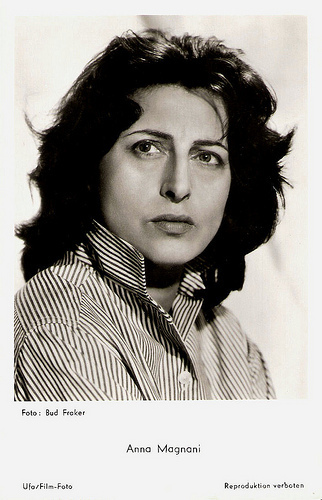
German postcard by Ufa, Berlin-Tempelhof, no. FK 4136. Photo: Bud Fraker.
The Italian Edith Piaf
Anna Magnani was born in Rome in 1908. She was the illegitimate child of Marina Magnani and an unknown father, whom Anna herself claimed was from the Calabria region of Italy (according to Wikipedia he was called Francesco Del Duce). She was raised by her maternal grandmother in a slum district of Rome after her mother left her.
At 14, she enrolled in a French convent school in Rome, where, she learned to speak French and play piano. She also developed a passion for acting from watching the nuns stage their Christmas play.
At age 17, she went on to study at Santa Cecilia's Corso Eleanora Duse (the Eleanora Duse Royal Academy of Dramatic Art) in Rome. To support herself, Magnani sang bawdy Roman songs in nightclubs and cabarets leading to her being dubbed ‘the Italian Edith Piaf’.
She began touring the countryside with small repertory companies, and had a small role in the silent film Scampolo (Augusto Genina, 1928) starring Carmen Boni .
In 1933 she was acting in experimental plays in Rome when she was discovered by Italian filmmaker Goffredo Alessandrini. She played in La Cieca di Sorrento/The Blind Woman of Sorrento (Nunzio Malasomma, 1934). They married in 1933, shortly before the film was released. Magnani retired from full-time acting to devote herself exclusively to her husband, although she continued to play smaller film parts.
Under Alessandrini, she next appeared in Cavalleria/Cavalry (Goffredo Alessandrini, 1936) with Amedeo Nazzari , followed by La principessa Tarakanova/Betrayal (Fyodor Otsep, Mario Soldati, 1938) featuring Annie Vernay . Alessandrini and Magnani separated in 1942 and finally divorced in 1950.
After their separation her son Luca was born, the result of a brief affair with Italian matinée idol Massimo Serato. Magnani's life was struck by tragedy when Luca came down with crippling polio at only 18 months of age. He never regained use of his legs. As a result, she spent most of her early earnings for specialists and hospitals.
In 1941, Magnani played the second female lead in the comedy of errors Teresa Venerdì/Do You Like Women (Vittorio De Sica, 1941) which writer-director Vittorio De Sica called Magnani’s ‘first true film’. In it she plays Loletta Prima, the girlfriend of Di Sica’s character, Pietro Vignali. But her international breakthrough role had still to come.
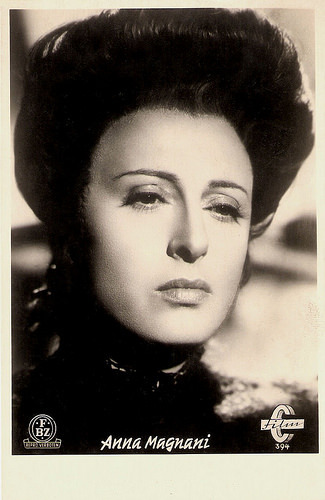
German postcard by FBZ, no. 394. Photo: Cfilm.
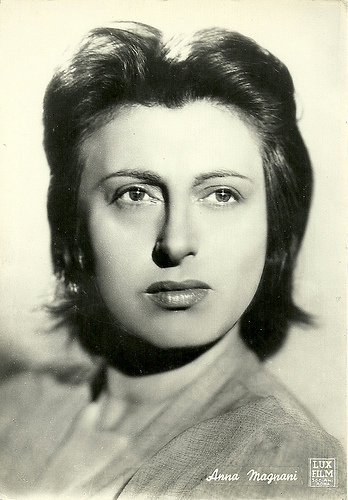
Italian postcard by Bromofoto, Milano, no. 104. Photo: Lux Film, Rome.
One of Cinema's Most Devastating Moments
Anna Magnani’s film career had spread over 18 years before she gained international renown as Pina in the neorealist milestone Roma, città aperta/Rome, Open City (Roberto Rossellini, 1945) about the final days of the Nazi occupation of Rome.
Magnani gave a brilliant performance as a woman who dies fighting to protect her husband, an underground fighter against the Nazis. Her harrowing death scene remains one of cinema's most devastating moments.
It established her as a star, although she lacked the conventional beauty and glamour often associated with the term. Slightly plump and rather short in stature with a face framed by unkempt raven hair and eyes encircled by deep, dark shadows, she smouldered with seething earthiness and volcanic temperament.
Roberto Rossellini was her lover at the time, and she collaborated with him on other films, including L'Amore/Love (Roberto Rossellini, 1948) a two part film including Il miracolo/The Miracle and Una voce umana/The Human Voice. In the former, she played a pregnant outcast peasant who was seduced by a stranger and comes to believe the child she subsequently carries is Christ. Magnani plumbs both the sorrow and the righteousness of being alone in the world. The latter film is based on Jean Cocteau's play about a woman desperately trying to salvage a relationship over the telephone. It is remarkable for the ways in which Magnani's powerful moments of silence segue into cries of despair.
Rossellini promised to direct her again in Stromboli, the next film he was preparing. However, when the screenplay was completed, he gave the role to Ingrid Bergman . This and his affair with the Swedish Hollywood star caused Magnani's breakup with Rossellini. As a result, she took on the starring role of Volcano/Vulcano (William Dieterle, 1949) with Rossano Brazzi , which was deliberately produced to invite comparison.
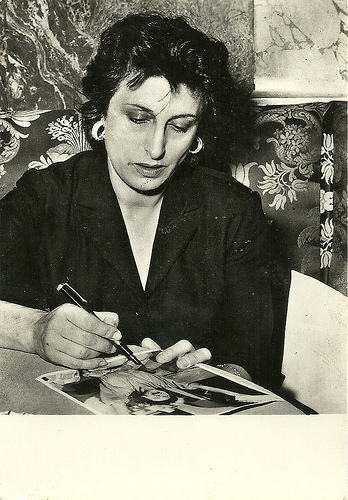
Italian postcard in the Series 'Hobby' by Bromostampa, Milano.
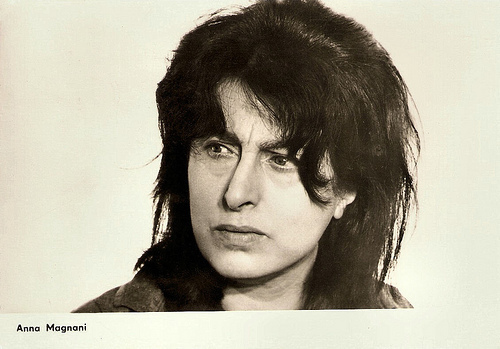
East-German postcard by VEB Progress Film-Vertrieb, Berlin, no. 2823, 1967. Sent by mail in East-Germany in 1974.
Prostitutes and Suffering Mothers
In 1950, Life magazine stated that Anna Magnani was "one of the most impressive actresses since Garbo." In Bellissima (Luchino Visconti, 1951) she played Maddalena, a blustery, obstinate stage mother who drags her daughter to Cinecittà for the 'Prettiest Girl in Rome' contest, with dreams that her plain daughter will be a star. Her emotions in the film went from those of rage and humiliation to maternal love.
She later starred as Camille, a commedia dell'arte actress torn between three men, a soldier, a bullfighter, and a viceroy, in Le Carrosse d'or/The Golden Coach (Jean Renoir, 1953).
In Hollywood she starred opposite Burt Lancaster as Serafina, the widowed mother of a teenage daughter in The Rose Tattoo (Daniel Mann, 1955). Screenwriter and close friend Tennessee Williams had based the character of Serafina on Magnani. He even stipulated that the film must star Magnani. It was Magnani's first English speaking role in a mainstream Hollywood movie, winning her the Academy Award, the BAFTA, the Golden Globe and the New York Film Critics Circle Award for Best Actress.
Magnani worked with Tennessee Williams again on The Fugitive Kind (Sidney Lumet, 1959), co-starring with Marlon Brando. In Hollywood she also appeared in Wild is the Wind (1957, George Cukor), for which she was again nominated for the Academy Award.
In Italy she played strong-willed prostitutes and suffering mothers in such films as the women-in-prison drama Nella città l'inferno/The Wild, Wild Women (Renato Castellani, 1958) with Giulietta Masina , and Mamma Roma (Pier Paolo Pasolini, 1962). In Mama Roma Magnani is both the mother and the whore, playing an irrepressible prostitute determined to give her teenage son a respectable middle-class life. It was controversial but also one of Magnani's most critically acclaimed films.
In this later period of her career, she also appeared on Italian television and acted on the stage, most notably in 1965 when she starred in La Lupa (She-Wolf), directed by Franco Zeffirelli, and in 1966 when she played the lead in Jean Anouilh's Medea, directed by Gian Carlo Menotti.
In the film comedy The Secret of Santa Vittoria (Stanley Kramer, 1969), she co-starred with Anthony Quinn as a fighting husband and wife. Magnani and Quinn did also feud in private and their animosity spilled over into their scenes. Reportedly she bit Quinn in the neck and kicked him so hard she broke a bone in her right foot.
Her final screen performance was a cameo in Fellini's Roma (Federico Fellini, 1972).
In 1973, Anna Magnani died at the age of 65 in Rome, after a long battle with pancreatic cancer. Her son Luca and her favourite director Roberto Rossellini were at her bedside. With Rossellini she'd patched up her disagreements some years before. It was reported that an enormous crowd turned out for her funeral in Italy, in a final public salute that is more typically reserved for Popes.
Scene from The Rose Tattoo (1953). Source: The SuppActress (YouTube).
Anna Magnani sings Scapricciatiello in Wild is the Wind (1957). Source: Minuit (YouTube).
Sources: Jason Ankeny (All Movie), (IMDb), Answers.com, Wikipedia and .

French postcard by Editions P.I., Paris, no. 386.

German postcard by Ufa, Berlin-Tempelhof, no. FK 4136. Photo: Bud Fraker.
The Italian Edith Piaf
Anna Magnani was born in Rome in 1908. She was the illegitimate child of Marina Magnani and an unknown father, whom Anna herself claimed was from the Calabria region of Italy (according to Wikipedia he was called Francesco Del Duce). She was raised by her maternal grandmother in a slum district of Rome after her mother left her.
At 14, she enrolled in a French convent school in Rome, where, she learned to speak French and play piano. She also developed a passion for acting from watching the nuns stage their Christmas play.
At age 17, she went on to study at Santa Cecilia's Corso Eleanora Duse (the Eleanora Duse Royal Academy of Dramatic Art) in Rome. To support herself, Magnani sang bawdy Roman songs in nightclubs and cabarets leading to her being dubbed ‘the Italian Edith Piaf’.
She began touring the countryside with small repertory companies, and had a small role in the silent film Scampolo (Augusto Genina, 1928) starring Carmen Boni .
In 1933 she was acting in experimental plays in Rome when she was discovered by Italian filmmaker Goffredo Alessandrini. She played in La Cieca di Sorrento/The Blind Woman of Sorrento (Nunzio Malasomma, 1934). They married in 1933, shortly before the film was released. Magnani retired from full-time acting to devote herself exclusively to her husband, although she continued to play smaller film parts.
Under Alessandrini, she next appeared in Cavalleria/Cavalry (Goffredo Alessandrini, 1936) with Amedeo Nazzari , followed by La principessa Tarakanova/Betrayal (Fyodor Otsep, Mario Soldati, 1938) featuring Annie Vernay . Alessandrini and Magnani separated in 1942 and finally divorced in 1950.
After their separation her son Luca was born, the result of a brief affair with Italian matinée idol Massimo Serato. Magnani's life was struck by tragedy when Luca came down with crippling polio at only 18 months of age. He never regained use of his legs. As a result, she spent most of her early earnings for specialists and hospitals.
In 1941, Magnani played the second female lead in the comedy of errors Teresa Venerdì/Do You Like Women (Vittorio De Sica, 1941) which writer-director Vittorio De Sica called Magnani’s ‘first true film’. In it she plays Loletta Prima, the girlfriend of Di Sica’s character, Pietro Vignali. But her international breakthrough role had still to come.

German postcard by FBZ, no. 394. Photo: Cfilm.

Italian postcard by Bromofoto, Milano, no. 104. Photo: Lux Film, Rome.
One of Cinema's Most Devastating Moments
Anna Magnani’s film career had spread over 18 years before she gained international renown as Pina in the neorealist milestone Roma, città aperta/Rome, Open City (Roberto Rossellini, 1945) about the final days of the Nazi occupation of Rome.
Magnani gave a brilliant performance as a woman who dies fighting to protect her husband, an underground fighter against the Nazis. Her harrowing death scene remains one of cinema's most devastating moments.
It established her as a star, although she lacked the conventional beauty and glamour often associated with the term. Slightly plump and rather short in stature with a face framed by unkempt raven hair and eyes encircled by deep, dark shadows, she smouldered with seething earthiness and volcanic temperament.
Roberto Rossellini was her lover at the time, and she collaborated with him on other films, including L'Amore/Love (Roberto Rossellini, 1948) a two part film including Il miracolo/The Miracle and Una voce umana/The Human Voice. In the former, she played a pregnant outcast peasant who was seduced by a stranger and comes to believe the child she subsequently carries is Christ. Magnani plumbs both the sorrow and the righteousness of being alone in the world. The latter film is based on Jean Cocteau's play about a woman desperately trying to salvage a relationship over the telephone. It is remarkable for the ways in which Magnani's powerful moments of silence segue into cries of despair.
Rossellini promised to direct her again in Stromboli, the next film he was preparing. However, when the screenplay was completed, he gave the role to Ingrid Bergman . This and his affair with the Swedish Hollywood star caused Magnani's breakup with Rossellini. As a result, she took on the starring role of Volcano/Vulcano (William Dieterle, 1949) with Rossano Brazzi , which was deliberately produced to invite comparison.

Italian postcard in the Series 'Hobby' by Bromostampa, Milano.

East-German postcard by VEB Progress Film-Vertrieb, Berlin, no. 2823, 1967. Sent by mail in East-Germany in 1974.
Prostitutes and Suffering Mothers
In 1950, Life magazine stated that Anna Magnani was "one of the most impressive actresses since Garbo." In Bellissima (Luchino Visconti, 1951) she played Maddalena, a blustery, obstinate stage mother who drags her daughter to Cinecittà for the 'Prettiest Girl in Rome' contest, with dreams that her plain daughter will be a star. Her emotions in the film went from those of rage and humiliation to maternal love.
She later starred as Camille, a commedia dell'arte actress torn between three men, a soldier, a bullfighter, and a viceroy, in Le Carrosse d'or/The Golden Coach (Jean Renoir, 1953).
In Hollywood she starred opposite Burt Lancaster as Serafina, the widowed mother of a teenage daughter in The Rose Tattoo (Daniel Mann, 1955). Screenwriter and close friend Tennessee Williams had based the character of Serafina on Magnani. He even stipulated that the film must star Magnani. It was Magnani's first English speaking role in a mainstream Hollywood movie, winning her the Academy Award, the BAFTA, the Golden Globe and the New York Film Critics Circle Award for Best Actress.
Magnani worked with Tennessee Williams again on The Fugitive Kind (Sidney Lumet, 1959), co-starring with Marlon Brando. In Hollywood she also appeared in Wild is the Wind (1957, George Cukor), for which she was again nominated for the Academy Award.
In Italy she played strong-willed prostitutes and suffering mothers in such films as the women-in-prison drama Nella città l'inferno/The Wild, Wild Women (Renato Castellani, 1958) with Giulietta Masina , and Mamma Roma (Pier Paolo Pasolini, 1962). In Mama Roma Magnani is both the mother and the whore, playing an irrepressible prostitute determined to give her teenage son a respectable middle-class life. It was controversial but also one of Magnani's most critically acclaimed films.
In this later period of her career, she also appeared on Italian television and acted on the stage, most notably in 1965 when she starred in La Lupa (She-Wolf), directed by Franco Zeffirelli, and in 1966 when she played the lead in Jean Anouilh's Medea, directed by Gian Carlo Menotti.
In the film comedy The Secret of Santa Vittoria (Stanley Kramer, 1969), she co-starred with Anthony Quinn as a fighting husband and wife. Magnani and Quinn did also feud in private and their animosity spilled over into their scenes. Reportedly she bit Quinn in the neck and kicked him so hard she broke a bone in her right foot.
Her final screen performance was a cameo in Fellini's Roma (Federico Fellini, 1972).
In 1973, Anna Magnani died at the age of 65 in Rome, after a long battle with pancreatic cancer. Her son Luca and her favourite director Roberto Rossellini were at her bedside. With Rossellini she'd patched up her disagreements some years before. It was reported that an enormous crowd turned out for her funeral in Italy, in a final public salute that is more typically reserved for Popes.
Scene from The Rose Tattoo (1953). Source: The SuppActress (YouTube).
Anna Magnani sings Scapricciatiello in Wild is the Wind (1957). Source: Minuit (YouTube).
Sources: Jason Ankeny (All Movie), (IMDb), Answers.com, Wikipedia and .
Published on December 29, 2014 22:00
December 28, 2014
Eddy Mitchell
French singer and actor Eddy Mitchell (1942) began his career in the late 1950s, with the rock & roll group Les Chaussettes Noires, and in 1963, he went solo. He also played in several French films. In black and white musical comedies of the 1960s he appeared as himself fronting his band, but his ‘real’ acting career started with the Oscar nominated Coup de torchon (1981). Now, after a career of 50 years, Mr. Eddy has become the tranquil daddy of French rock & roll.
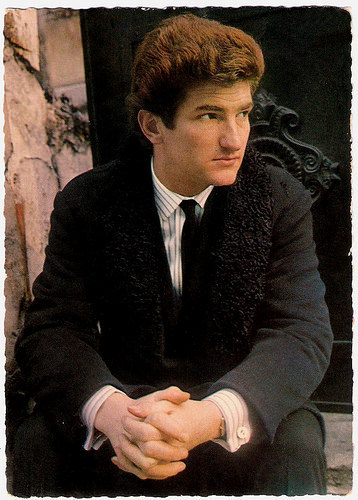
French postcard by Publistar, Marseille, no. 927. Photo: Patrick Bertrand.
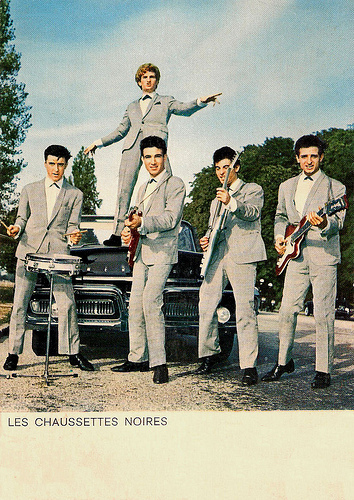
French postcard by Editions Publistar, Marseille, no. 727 C. Photo: Rolland Carré.
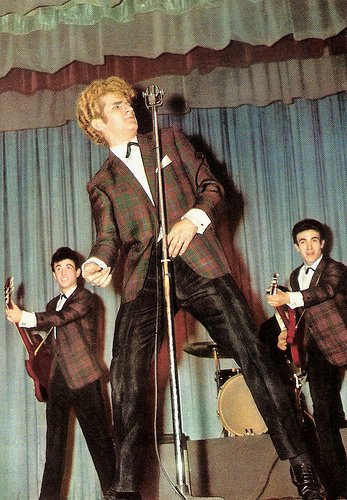
French postcard by Editions P.I., Paris, no. 1079. Photo: Noa.
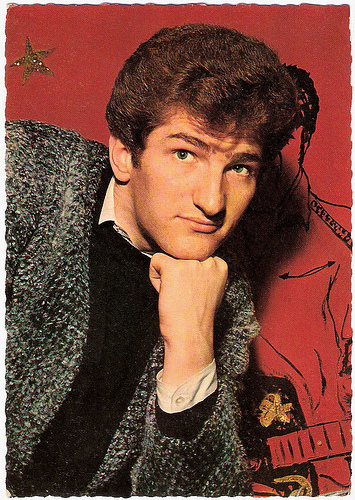
French postcard by PSG, no. 859. Photo: Gérard Neuvecelle.
The Black Socks
Eddy Mitchell was born as Claude Moine in Paris in 1942. He spent his childhood in Belleville, a working class quarter of the capital. His mother worked in a bank and his father was a mechanic at the RATP (the Paris transport authority).
After several years at the Lycée Turgot he obtained his certificate of studies. Only fourteen, he went to work at Crédit Lyonnais. Later he was a motorcycle courier for an insurance company.
At the end of the 1950s, Claude discovered rock & roll, newly arrived from America. His favourite stars were Bill Haley and Gene Vincent. Young people in Paris, eager to hear the new music, began flocking to the now legendary night club, Le Golf Drouot, opened in 1956.
Claude, who became known as ‘Schmoll’, started a group with a friend, Jean-Pierre Chicheportiche, who recruited two more young musicians. After practice sessions and appearances at the Golf Drouot, they began looking around for a record label. Their first audition was with Barclay. The musical director, Jean Fernandez, was impressed.
Claude took his stage name from the American expatriate tough-guy actor Eddie Constantine . By the end of 1960, his group had become Les Chaussettes Noires (The Black Socks). The name was inspired by a publicity campaign for socks made by Lainières de Roubaix, with whom Eddie Constantine had a promotional contract.
The band found almost instant success. In 1961 Les Chaussettes Noires released six singles and sold two million records, including 800,000 copies of Daniela. He also appeared in the film De quoi tu te mêles Daniela!/Daniela, Criminal Strip-Tease (Max Pécas, 1961) starring Elke Sommer .
This bit part was followed by other appearances with Les Chausettes Noires in films like Les parisiennes (Jacques Poitrenaud, 1962) and Une grosse tête/A Fat Head (Claude de Givray, 1962) starring Eddie Constantine .
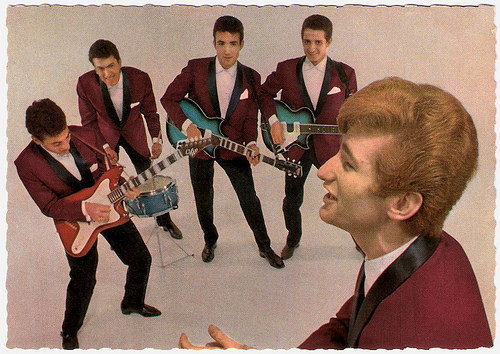
French postcard by E.D.U.G., no. 211. Photo: Herman Leonard / Barclay.
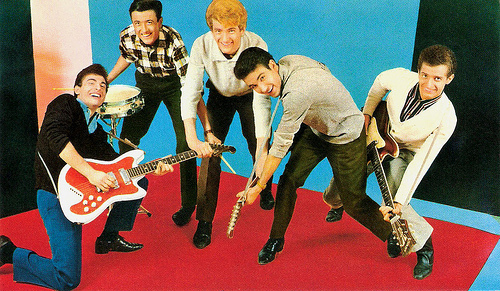
French postcard by E.D.U.G., no. 250, offered by Corvisart. Photo: Roland Carré.
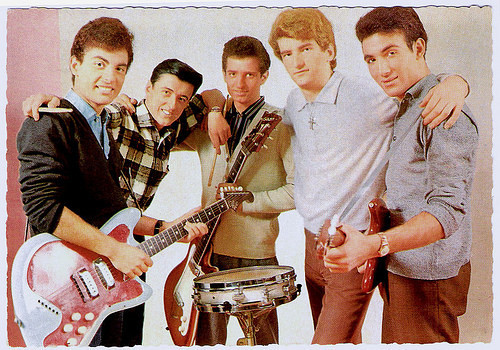
French postcard by E.D.U.G., no. 210. Photo: Roland Carré.
The Rhythm Was Frantic
In March 1962, Eddy Mitchell was called up for his military service, during which he nevertheless found time to record new tracks and play at dances with Les Chaussettes Noires. Jean Fernandez had in mind a solo career for Eddy, whose vocal talents he rated highly.
In November 1962, he recorded a four track EP, Mais reviens-moi. When he finished his military service in August 1963, Eddy Mitchell was able to devote himself entirely to a solo career.
In October he went to London to record new material with English musicians (including the very young Jimmy Page). The result was Eddy in London, an album of cover versions of numbers by his rock & roll heroes, Eddie Cochrane, Elvis Presley, Gene Vincent and Bill Haley.
In 1964, he was back in the London studios again recording a second album, Panorama. The rhythm was frantic. The third solo album, modestly entitled, Toute la ville en parle, Eddy est en ville (The Whole Town Is Talking, Eddy is in Town), came out in 1964. This was the first recording of original material by the singer, who signed lyrics such as Toujours un coin qui me rappelle (Always a Corner Which Reminds Me). Until then he had only sung French adaptations of English lyrics.
After rock & roll, he discovered the soul of James Brown and Otis Redding and changed musical direction. In 1965, his new album, Du rock ‘n’ roll au rhythm & blues (From Rock & Roll to Rhythm & Blues), included titles such as J’avais deux amis (I Had Two Friends) and Si tu n’étais pas mon frère (If You Are Not My Brother). The horn section became more and more prominent, which suited the artist’s stage shows perfectly.
By the mid-sixties, Mitchell was already very different from the other singers of the period, most of whom had climbed on to the yéyé bandwagon. De Londres à Memphis (From London To Memphis) was recorded in 1967, the year Eddy’s dream came true: to record in America, cradle of rock, R&B and country. He came back with a new hit Alice.
Now turned thirty, his career seemed to have taken off for good. Nevertheless, 1968 was the beginning of a lull in his career. Only his hard core fans greeted each new album release with the same old fervour. Meanwhile, Eddy, ever faithful to himself, polished his tranquil rock star persona. None of the six or so albums which he released between 1968 and 1974 sold hugely.
In 1974, Barclay re-released some of the old Chaussette Noires numbers. Unexpectedly, sales of these records rocketed. The defunct band’s leader had the idea of starting it up again. Mitchell refused outright. His solo career quickly took off again with the release of Rocking in Nashville, which went to the Number 1 in the French album charts, where it stayed for several weeks. He returned to the States to record Made in U.S.A. The album was a golden disc in France. Eddy continued recording albums at the rate of one a year.
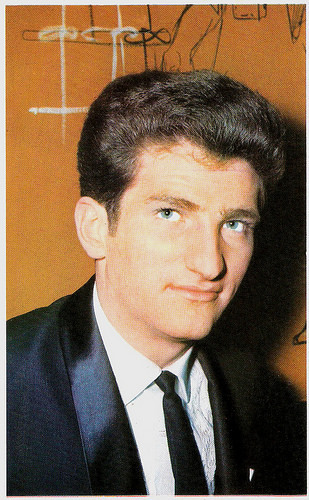
French postcard by Editions P.I., Paris, offered by Corvisart, Epinal, no. 1118. Photo: Anders.
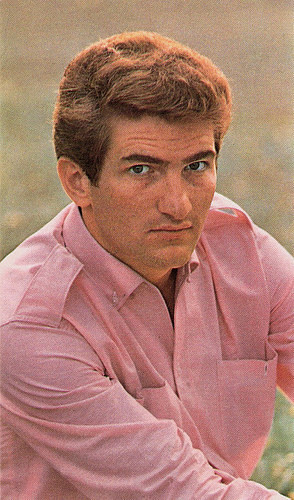
French postcard by PSG, offered by Corvisart, Epinal, no. 1233. Photo: Barclay.
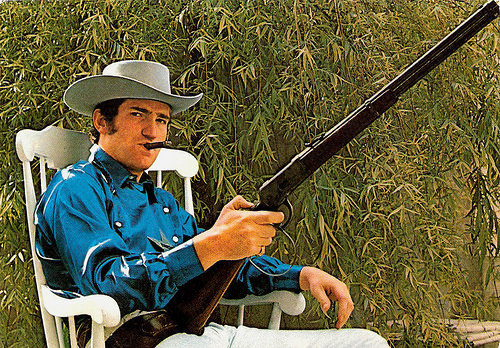
French postcard by Editions Lyna, Paris, no. 2013. Photo: Casanova - Formidable.
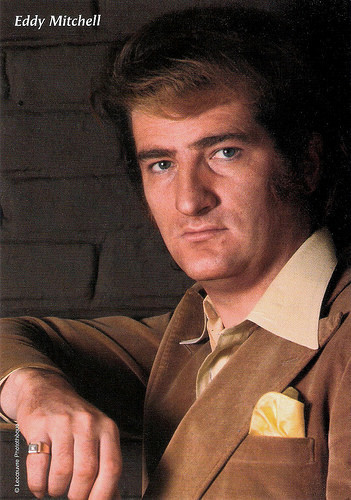
French postcard by Universal Collections, 2003, a limited edition for L'Encyclopédie de la Chanson Française.
Cinema, Music and Television
The new decade began well for Eddy Mitchell. His professionalism was admired by everybody. In 1980 ‘Monsieur Eddy’, as he was now known, celebrated twenty years in the music business with Happy Birthday. The album sold 500.000 copies, thanks to the hit number which has become his signature tune, Couleur menthe à l’eau (Color mint in the water).
After a two year break, he returned to L’Olympia, where he recorded a triple live album. But, at the beginning of the eighties, it was the cinema which seemed to interest him most. Film director Bertrand Tavernier gave him a real chance to prove himself as an actor in Coup de torchon/Clean Slate (Bertrand Tavernier, 1981) starring Philippe Noiret. After watching the dailies Mitchell reportedly thought he was so bad that he insisted to do some of his scenes once again. But no one agreed, and the success of the film led to several more role offers.
In 1982, his love for cinema led him to host and produce, La dernière séance (The last session), a programme entirely devoted to American films from the 1950s on the French television channel, FR3. He hosted this TV show till 1997.
After withdrawing Barclay’s distribution rights, Mitchell signed a contract with RCA in 1983. The first two albums released on this label were respectively a compilation and a collection of previously unreleased recordings.
He appeared in more films, including Attention une femme peut en cacher une autre/My Other Husband (Georges Lautner, 1983) starring Miou-Miou and the thriller A mort l’arbitre/Kill the Referee (Jean-Pierre Mocky, 1984) with Michel Serrault.
In 1984 an album of new material was released: Racines. One of the most accomplished of all his albums, Racines received the Académie Charles Cros award. Again in the nostalgic vein, it included Nashville ou Belleville and Comme quand j’étais môme(As when I was a kid).
From then on he divided his professional life between the cinema, music and television. The variety of activities seemed to suit him perfectly. His films included I Love You (Marco Ferreri, 1986), 'Round Midnight (Bertrand Tavernier, 1986) starring real-life jazz legend Dexter Gordon, and Bis ans Ende der Welt/Until the End of the World (Wim Wenders, 1991) starring William Hurt.
Passing from one to the other, Eddy Mitchell was as at ease in front of the cameras as he was in front of the microphone. He gradually turned into a crooner with the warm, ample voice of a rock singer. After writing P’tit Claude, a collection of short stories about the Belleville quarter of Paris where he grew up, Mitchell acted in the comedy Le bonheur est dans le pré/The happiness is in the meadow (Etienne Chatiliez, 1995), a huge box office success for which he was awarded a César.
He then embarked on a series of recording sessions in Memphis, Nashville and Paris. He kept appearing in films such as the thriller Un printemps à Paris/A Winter in Paris (Jacques Bral, 2006) and Bambou (Didier Bourdon, 2009).
In 2008, he appeared for the first time on a theatre stage with actress Cécile de France in the play Le temps des cerises (Cherry season), for a run of 100 performances at the Théâtre de la Madeleine, in Paris. In 2009, he announced on a TV show that his 2010 tour would be his last, since he wanted to be 'polite to my public', and also so that he could spend more time on his film work and TV production company.
Eddy Michell continues his film career on full speed. Recently he starred as a father suffering from a neurodegenerative disease in Grand depart/Great start (Nicolas Mercier, 2013), in the comedy drama Les petits princes/Little princes (Vianney Lebasque, 2013) and Salaud, on t'aime/Bastard, we love you (Claude Lelouch, 2014) opposite that other French rock & roll legend, Johnny Hallyday.
Les Chaussettes Noires play Je t'aime trop (I Love Too Much) in a Scopitone clip. Source: JoaoScatarino (YouTube).
Eddy Mitchell sings Sur La Route De Memphis (On the Way To Memphis)(1976). Source: Azargoth (YouTube).
French trailer for Coup de torchon/Clean Slate (1981). Source: WorleyClarence (YouTube).
French trailer for A mort l’arbitre/Kill the Referee (1984). Source: Ibena65 (YouTube).
Sources: Radio France International (French), (IMDb), Wikipedia and .

French postcard by Publistar, Marseille, no. 927. Photo: Patrick Bertrand.

French postcard by Editions Publistar, Marseille, no. 727 C. Photo: Rolland Carré.

French postcard by Editions P.I., Paris, no. 1079. Photo: Noa.

French postcard by PSG, no. 859. Photo: Gérard Neuvecelle.
The Black Socks
Eddy Mitchell was born as Claude Moine in Paris in 1942. He spent his childhood in Belleville, a working class quarter of the capital. His mother worked in a bank and his father was a mechanic at the RATP (the Paris transport authority).
After several years at the Lycée Turgot he obtained his certificate of studies. Only fourteen, he went to work at Crédit Lyonnais. Later he was a motorcycle courier for an insurance company.
At the end of the 1950s, Claude discovered rock & roll, newly arrived from America. His favourite stars were Bill Haley and Gene Vincent. Young people in Paris, eager to hear the new music, began flocking to the now legendary night club, Le Golf Drouot, opened in 1956.
Claude, who became known as ‘Schmoll’, started a group with a friend, Jean-Pierre Chicheportiche, who recruited two more young musicians. After practice sessions and appearances at the Golf Drouot, they began looking around for a record label. Their first audition was with Barclay. The musical director, Jean Fernandez, was impressed.
Claude took his stage name from the American expatriate tough-guy actor Eddie Constantine . By the end of 1960, his group had become Les Chaussettes Noires (The Black Socks). The name was inspired by a publicity campaign for socks made by Lainières de Roubaix, with whom Eddie Constantine had a promotional contract.
The band found almost instant success. In 1961 Les Chaussettes Noires released six singles and sold two million records, including 800,000 copies of Daniela. He also appeared in the film De quoi tu te mêles Daniela!/Daniela, Criminal Strip-Tease (Max Pécas, 1961) starring Elke Sommer .
This bit part was followed by other appearances with Les Chausettes Noires in films like Les parisiennes (Jacques Poitrenaud, 1962) and Une grosse tête/A Fat Head (Claude de Givray, 1962) starring Eddie Constantine .

French postcard by E.D.U.G., no. 211. Photo: Herman Leonard / Barclay.

French postcard by E.D.U.G., no. 250, offered by Corvisart. Photo: Roland Carré.

French postcard by E.D.U.G., no. 210. Photo: Roland Carré.
The Rhythm Was Frantic
In March 1962, Eddy Mitchell was called up for his military service, during which he nevertheless found time to record new tracks and play at dances with Les Chaussettes Noires. Jean Fernandez had in mind a solo career for Eddy, whose vocal talents he rated highly.
In November 1962, he recorded a four track EP, Mais reviens-moi. When he finished his military service in August 1963, Eddy Mitchell was able to devote himself entirely to a solo career.
In October he went to London to record new material with English musicians (including the very young Jimmy Page). The result was Eddy in London, an album of cover versions of numbers by his rock & roll heroes, Eddie Cochrane, Elvis Presley, Gene Vincent and Bill Haley.
In 1964, he was back in the London studios again recording a second album, Panorama. The rhythm was frantic. The third solo album, modestly entitled, Toute la ville en parle, Eddy est en ville (The Whole Town Is Talking, Eddy is in Town), came out in 1964. This was the first recording of original material by the singer, who signed lyrics such as Toujours un coin qui me rappelle (Always a Corner Which Reminds Me). Until then he had only sung French adaptations of English lyrics.
After rock & roll, he discovered the soul of James Brown and Otis Redding and changed musical direction. In 1965, his new album, Du rock ‘n’ roll au rhythm & blues (From Rock & Roll to Rhythm & Blues), included titles such as J’avais deux amis (I Had Two Friends) and Si tu n’étais pas mon frère (If You Are Not My Brother). The horn section became more and more prominent, which suited the artist’s stage shows perfectly.
By the mid-sixties, Mitchell was already very different from the other singers of the period, most of whom had climbed on to the yéyé bandwagon. De Londres à Memphis (From London To Memphis) was recorded in 1967, the year Eddy’s dream came true: to record in America, cradle of rock, R&B and country. He came back with a new hit Alice.
Now turned thirty, his career seemed to have taken off for good. Nevertheless, 1968 was the beginning of a lull in his career. Only his hard core fans greeted each new album release with the same old fervour. Meanwhile, Eddy, ever faithful to himself, polished his tranquil rock star persona. None of the six or so albums which he released between 1968 and 1974 sold hugely.
In 1974, Barclay re-released some of the old Chaussette Noires numbers. Unexpectedly, sales of these records rocketed. The defunct band’s leader had the idea of starting it up again. Mitchell refused outright. His solo career quickly took off again with the release of Rocking in Nashville, which went to the Number 1 in the French album charts, where it stayed for several weeks. He returned to the States to record Made in U.S.A. The album was a golden disc in France. Eddy continued recording albums at the rate of one a year.

French postcard by Editions P.I., Paris, offered by Corvisart, Epinal, no. 1118. Photo: Anders.

French postcard by PSG, offered by Corvisart, Epinal, no. 1233. Photo: Barclay.

French postcard by Editions Lyna, Paris, no. 2013. Photo: Casanova - Formidable.

French postcard by Universal Collections, 2003, a limited edition for L'Encyclopédie de la Chanson Française.
Cinema, Music and Television
The new decade began well for Eddy Mitchell. His professionalism was admired by everybody. In 1980 ‘Monsieur Eddy’, as he was now known, celebrated twenty years in the music business with Happy Birthday. The album sold 500.000 copies, thanks to the hit number which has become his signature tune, Couleur menthe à l’eau (Color mint in the water).
After a two year break, he returned to L’Olympia, where he recorded a triple live album. But, at the beginning of the eighties, it was the cinema which seemed to interest him most. Film director Bertrand Tavernier gave him a real chance to prove himself as an actor in Coup de torchon/Clean Slate (Bertrand Tavernier, 1981) starring Philippe Noiret. After watching the dailies Mitchell reportedly thought he was so bad that he insisted to do some of his scenes once again. But no one agreed, and the success of the film led to several more role offers.
In 1982, his love for cinema led him to host and produce, La dernière séance (The last session), a programme entirely devoted to American films from the 1950s on the French television channel, FR3. He hosted this TV show till 1997.
After withdrawing Barclay’s distribution rights, Mitchell signed a contract with RCA in 1983. The first two albums released on this label were respectively a compilation and a collection of previously unreleased recordings.
He appeared in more films, including Attention une femme peut en cacher une autre/My Other Husband (Georges Lautner, 1983) starring Miou-Miou and the thriller A mort l’arbitre/Kill the Referee (Jean-Pierre Mocky, 1984) with Michel Serrault.
In 1984 an album of new material was released: Racines. One of the most accomplished of all his albums, Racines received the Académie Charles Cros award. Again in the nostalgic vein, it included Nashville ou Belleville and Comme quand j’étais môme(As when I was a kid).
From then on he divided his professional life between the cinema, music and television. The variety of activities seemed to suit him perfectly. His films included I Love You (Marco Ferreri, 1986), 'Round Midnight (Bertrand Tavernier, 1986) starring real-life jazz legend Dexter Gordon, and Bis ans Ende der Welt/Until the End of the World (Wim Wenders, 1991) starring William Hurt.
Passing from one to the other, Eddy Mitchell was as at ease in front of the cameras as he was in front of the microphone. He gradually turned into a crooner with the warm, ample voice of a rock singer. After writing P’tit Claude, a collection of short stories about the Belleville quarter of Paris where he grew up, Mitchell acted in the comedy Le bonheur est dans le pré/The happiness is in the meadow (Etienne Chatiliez, 1995), a huge box office success for which he was awarded a César.
He then embarked on a series of recording sessions in Memphis, Nashville and Paris. He kept appearing in films such as the thriller Un printemps à Paris/A Winter in Paris (Jacques Bral, 2006) and Bambou (Didier Bourdon, 2009).
In 2008, he appeared for the first time on a theatre stage with actress Cécile de France in the play Le temps des cerises (Cherry season), for a run of 100 performances at the Théâtre de la Madeleine, in Paris. In 2009, he announced on a TV show that his 2010 tour would be his last, since he wanted to be 'polite to my public', and also so that he could spend more time on his film work and TV production company.
Eddy Michell continues his film career on full speed. Recently he starred as a father suffering from a neurodegenerative disease in Grand depart/Great start (Nicolas Mercier, 2013), in the comedy drama Les petits princes/Little princes (Vianney Lebasque, 2013) and Salaud, on t'aime/Bastard, we love you (Claude Lelouch, 2014) opposite that other French rock & roll legend, Johnny Hallyday.
Les Chaussettes Noires play Je t'aime trop (I Love Too Much) in a Scopitone clip. Source: JoaoScatarino (YouTube).
Eddy Mitchell sings Sur La Route De Memphis (On the Way To Memphis)(1976). Source: Azargoth (YouTube).
French trailer for Coup de torchon/Clean Slate (1981). Source: WorleyClarence (YouTube).
French trailer for A mort l’arbitre/Kill the Referee (1984). Source: Ibena65 (YouTube).
Sources: Radio France International (French), (IMDb), Wikipedia and .
Published on December 28, 2014 22:00
December 27, 2014
Michael Praed
British stage and film actor Michael Praed (1960) is best known for his roles in the TV series Robin of Sherwood (1984-1985) and Dynasty (1985-1986). He also appeared in several British and American films, but somehow his promising film career went nowhere.
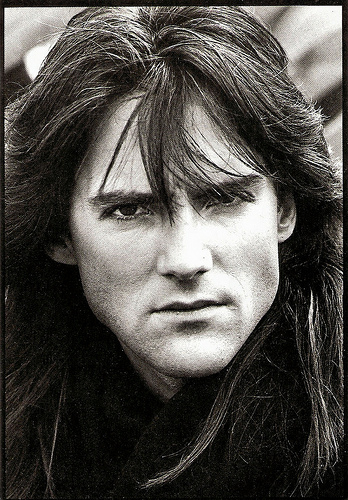
British postcard by Santoro Graphics, London, no. BW 133.
Robin of Loxley
Michael Praed was born as Michael David Prince in Berkeley, England in 1960. His parents were Derrick and Kay Prince, with whom he spent his early years in Iran because his father worked as an accountant for a petroleum company.
Michael was sent back to England for a public school education, which he did not enjoy. He then attended the Guildhall School of Music and Drama in London. As there was already a Michael Prince listed in Equity, Michael chose the surname ‘Praed’ from the phone book.
He began his career in repertory theatre before moving on to roles in London's West End. Praed's first big break occurred in playing in Joseph Papp's 1982 revival of The Pirates of Penzance with Tim Curry in the West End.
The producers of the TV series Robin of Sherwood spotted Praed and cast him as Robin of Loxley a.k.a. Robin Hood. The BAFTA winning Robin of Sherwood (1984-1985) was a huge hit and gained an international cult status.
After two successful seasons as Robin, Praed was lured to Broadway to star in The Three Musketeers. His Broadway adventure led to him being cast as Prince Michael of Moldavia in Aaron Spelling's prime time soap Dynasty (1985-1986).
After this, Praed starred in the SciFi horror Nightflyers (Robert Collector, 1986), Writer's Block (Charles Correll, 1991), and Son of Darkness: To Die For II (David Price, 1991). Between these B-films, Michael Praed worked on writing and recording music in his own studio.

British postcard by Reflex, Watford, no. PC 153, 1985. Photo: Brian Aris.
Phileas Fogg
At the end of 1991, Michael Praed left Los Angeles for the lead in an Irish production of the classic musical Carousel. Immediately following this Rogers and Hammerstein musical, he found himself back in London playing the lead in the West End production of Aspects of Love by Andrew Lloyd Webber.
The British televised mini-series Riders (Gabrielle Beaumont, 1993) followed, based a novel by Jilly Cooper.
His next stage endeavour was Harold Pinter's terse, tense drama The Caretaker. In 1994 he starred opposite Susannah York in the drama September Tide in the West End.
Praed then dived into the role of the devious, womanizing Gary in the comedy film Staggered (Martin Clunes, 1994). Subsequently, he accepted a regular role in the British television series Crown Prosecutor (John Stroud, 1995).
In 1995, he returned once again to the West End for Noel Coward's Design for Living with Rachel Weisz. Praed was brought as a replacement in the last two weeks of the run and learned the three act play over a single weekend. The next year he played the lead in Barry Manilow's Copacabana: The Musical, on its first national tour of Britain.
Praed made a cameo as the Hitman in the film Darkness Falls (Gerry Lively, 1999) with Robin of Sherwood comrade Ray Winstone. In Canada, he took the regular role of the Victorian aristocrat Phileas Fogg in the Canadian television series The Secret Adventures of Jules Verne (Gavin Scott, 2000), which developed a devoted following.
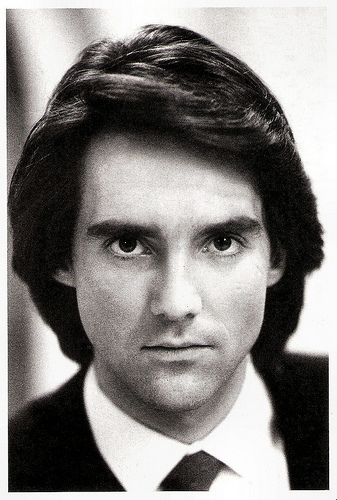
British postcard by Statics, London, no. PC 81.
Captain Von Trapp
Michael Praed played The Queen in the film comedy 9 Dead Gay Guys (Lab Ky Mo, 2002), which was shunned at Cannes but won awards at other, smaller festivals.
His next appearance was in Susan Stroman's Tony Award winning musical Contact back in London's West End (2003). He also appeared in such stage productions as Somerset Maugham's The Constant Wife, the musical Beautiful and Damned, Misery with Susan Penhaligon and in Anthony Shaffer's Sleuth.
On TV Praed was seen in popular series as Casualty (2002-2003) and The Bill (2005). Along with his acting, Praed has also recorded a number of narrations. In 2007, Praed was a cast member of the Blake's 7 audio adventure Rebel for B7 Media. He portrayed passenger Nelson Morris in the docudrama Hindenburg: Titanic of the Skies (Sean Grundy, 2007) a re-examination of the German zeppelin's spectacular explosion over New Jersey on the eve of World War II. He has also been the regular narrator of Timewatch (2003-2009), BBC TV's award winning documentary series.
Michael Praed was married to Karen Landau from 1994 till their divorce in 2009. They have two children, son Gabriel (1994) and daughter Frankie (1996). In recent years, appeared on stage as Captain Von Trapp in The Sound of Music (2009–2011), as Dexter Haven in High Society (2013) and as John Greenwood in The White Carnation (2014).
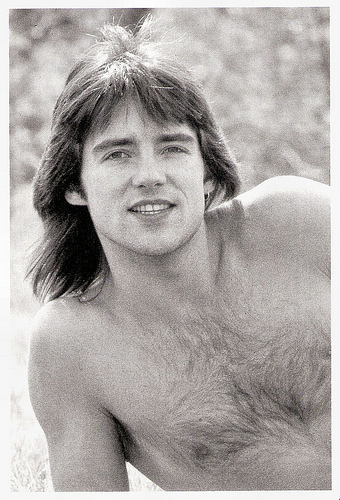
British postcard by Statics, London, no. PC 80.
Sources: Wikipedia and

British postcard by Santoro Graphics, London, no. BW 133.
Robin of Loxley
Michael Praed was born as Michael David Prince in Berkeley, England in 1960. His parents were Derrick and Kay Prince, with whom he spent his early years in Iran because his father worked as an accountant for a petroleum company.
Michael was sent back to England for a public school education, which he did not enjoy. He then attended the Guildhall School of Music and Drama in London. As there was already a Michael Prince listed in Equity, Michael chose the surname ‘Praed’ from the phone book.
He began his career in repertory theatre before moving on to roles in London's West End. Praed's first big break occurred in playing in Joseph Papp's 1982 revival of The Pirates of Penzance with Tim Curry in the West End.
The producers of the TV series Robin of Sherwood spotted Praed and cast him as Robin of Loxley a.k.a. Robin Hood. The BAFTA winning Robin of Sherwood (1984-1985) was a huge hit and gained an international cult status.
After two successful seasons as Robin, Praed was lured to Broadway to star in The Three Musketeers. His Broadway adventure led to him being cast as Prince Michael of Moldavia in Aaron Spelling's prime time soap Dynasty (1985-1986).
After this, Praed starred in the SciFi horror Nightflyers (Robert Collector, 1986), Writer's Block (Charles Correll, 1991), and Son of Darkness: To Die For II (David Price, 1991). Between these B-films, Michael Praed worked on writing and recording music in his own studio.

British postcard by Reflex, Watford, no. PC 153, 1985. Photo: Brian Aris.
Phileas Fogg
At the end of 1991, Michael Praed left Los Angeles for the lead in an Irish production of the classic musical Carousel. Immediately following this Rogers and Hammerstein musical, he found himself back in London playing the lead in the West End production of Aspects of Love by Andrew Lloyd Webber.
The British televised mini-series Riders (Gabrielle Beaumont, 1993) followed, based a novel by Jilly Cooper.
His next stage endeavour was Harold Pinter's terse, tense drama The Caretaker. In 1994 he starred opposite Susannah York in the drama September Tide in the West End.
Praed then dived into the role of the devious, womanizing Gary in the comedy film Staggered (Martin Clunes, 1994). Subsequently, he accepted a regular role in the British television series Crown Prosecutor (John Stroud, 1995).
In 1995, he returned once again to the West End for Noel Coward's Design for Living with Rachel Weisz. Praed was brought as a replacement in the last two weeks of the run and learned the three act play over a single weekend. The next year he played the lead in Barry Manilow's Copacabana: The Musical, on its first national tour of Britain.
Praed made a cameo as the Hitman in the film Darkness Falls (Gerry Lively, 1999) with Robin of Sherwood comrade Ray Winstone. In Canada, he took the regular role of the Victorian aristocrat Phileas Fogg in the Canadian television series The Secret Adventures of Jules Verne (Gavin Scott, 2000), which developed a devoted following.

British postcard by Statics, London, no. PC 81.
Captain Von Trapp
Michael Praed played The Queen in the film comedy 9 Dead Gay Guys (Lab Ky Mo, 2002), which was shunned at Cannes but won awards at other, smaller festivals.
His next appearance was in Susan Stroman's Tony Award winning musical Contact back in London's West End (2003). He also appeared in such stage productions as Somerset Maugham's The Constant Wife, the musical Beautiful and Damned, Misery with Susan Penhaligon and in Anthony Shaffer's Sleuth.
On TV Praed was seen in popular series as Casualty (2002-2003) and The Bill (2005). Along with his acting, Praed has also recorded a number of narrations. In 2007, Praed was a cast member of the Blake's 7 audio adventure Rebel for B7 Media. He portrayed passenger Nelson Morris in the docudrama Hindenburg: Titanic of the Skies (Sean Grundy, 2007) a re-examination of the German zeppelin's spectacular explosion over New Jersey on the eve of World War II. He has also been the regular narrator of Timewatch (2003-2009), BBC TV's award winning documentary series.
Michael Praed was married to Karen Landau from 1994 till their divorce in 2009. They have two children, son Gabriel (1994) and daughter Frankie (1996). In recent years, appeared on stage as Captain Von Trapp in The Sound of Music (2009–2011), as Dexter Haven in High Society (2013) and as John Greenwood in The White Carnation (2014).

British postcard by Statics, London, no. PC 80.
Sources: Wikipedia and
Published on December 27, 2014 23:00
December 26, 2014
Tragödie der Liebe (1923)
The last film special of 2014 is about the Weimar production, Tragödie der Liebe/Love Tragedy (1923). This silent film serial in four parts was produced and directed by Joe May. His wife, Mia May, played the leading role. The villain was played by the great Emil Jannings.
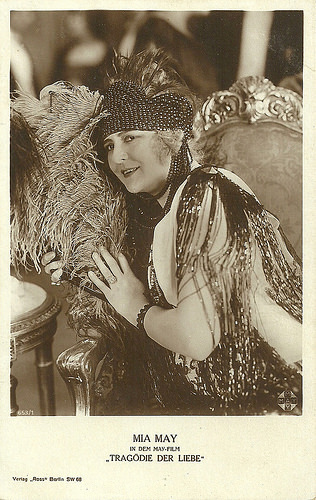
German postcard by Ross Verlag, no. 653/1, 1919-1924. Photo: May Film. Publicity still for Tragödie der Liebe/Love Tragedy (Joe May, 1923) with Mia May .
Murder
When the husband of countess Manon Moreau ( Mia May ) is murdered, suspicion falls on André Rabatin ( Vladimir Gajdarov ), who manages to convince the countess it was all an accident.
When also the count's servant gets murdered, the real culprit of this murder is revealed: the wrestler Ombrade ( Emil Jannings ), who tried to prevent a secret rendez-vous between his girlfriend Musette ( Erika Gläsnner ) and the count.
While the countess leaves the courtroom a free woman, Rabatin and Ombrade are condemned to forced labour.
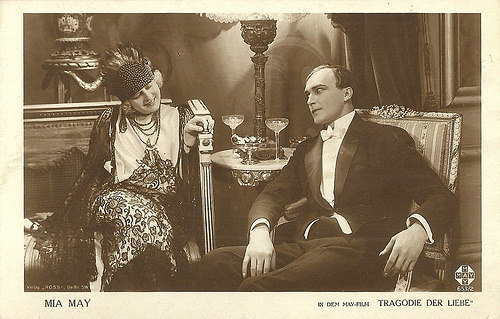
German postcard by Ross Verlag, no. 653/2. Photo: May-Film. Publicity still of Mia May and Vladimir Gajdarov in Tragödie der Liebe (Joe May, 1923).
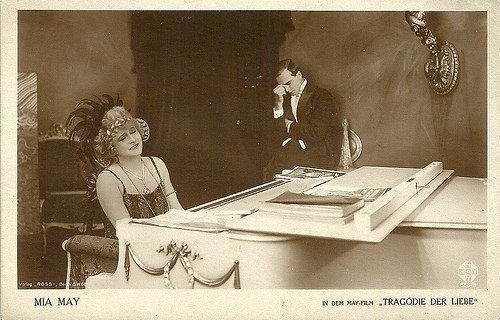
German postcard by Ross Verlag, no. 653/3. Photo: May-Film. Publicity still of Mia May and Vladimir Gajdarov in Tragödie der Liebe (Joe May, 1923).
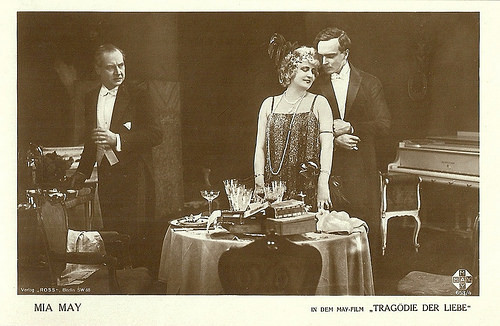
German postcard by Ross Verlag, no. 653/4. Photo: May Film. Publicity still of Mia May and Vladimir Gajdarov in Tragödie der Liebe (Joe May, 1923).
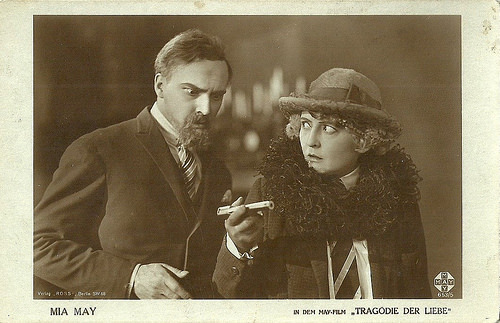
German postcard by Ross Verlag, no. 653/5. Photo: May-Film. Publicity still of Mia May and Vladimir Gajdarov in Tragödie der Liebe (Joe May, 1923).
Jealousy
Ten years after:
Manon returns to Paris and finds out that her daughter Kitty, living with her grandmother, and André, released from prison, have an affair. She begs him not to destroy her daughter's life as well.
Ombrade, released from prison and made jealous by Musette, enters the house and kills André in a fight.
While Manon is first suspected, in the end mother and daughter are cleared from all suspicion.
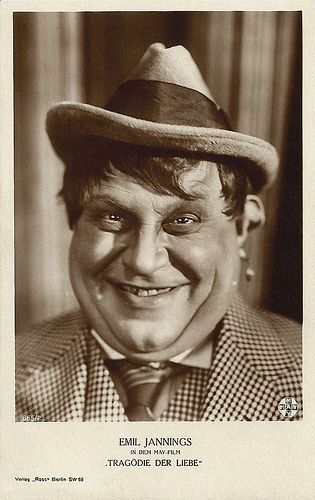
German postcard by Ross Verlag, no. 665/2, 1919-1924. Photo: May Film. Publicity still for Tragödie der Liebe/Love Tragedy (1923) with Emil Jannings .
Source: Filmportal.de (German), Wikipedia (German) and IMDb.

German postcard by Ross Verlag, no. 653/1, 1919-1924. Photo: May Film. Publicity still for Tragödie der Liebe/Love Tragedy (Joe May, 1923) with Mia May .
Murder
When the husband of countess Manon Moreau ( Mia May ) is murdered, suspicion falls on André Rabatin ( Vladimir Gajdarov ), who manages to convince the countess it was all an accident.
When also the count's servant gets murdered, the real culprit of this murder is revealed: the wrestler Ombrade ( Emil Jannings ), who tried to prevent a secret rendez-vous between his girlfriend Musette ( Erika Gläsnner ) and the count.
While the countess leaves the courtroom a free woman, Rabatin and Ombrade are condemned to forced labour.

German postcard by Ross Verlag, no. 653/2. Photo: May-Film. Publicity still of Mia May and Vladimir Gajdarov in Tragödie der Liebe (Joe May, 1923).

German postcard by Ross Verlag, no. 653/3. Photo: May-Film. Publicity still of Mia May and Vladimir Gajdarov in Tragödie der Liebe (Joe May, 1923).

German postcard by Ross Verlag, no. 653/4. Photo: May Film. Publicity still of Mia May and Vladimir Gajdarov in Tragödie der Liebe (Joe May, 1923).

German postcard by Ross Verlag, no. 653/5. Photo: May-Film. Publicity still of Mia May and Vladimir Gajdarov in Tragödie der Liebe (Joe May, 1923).
Jealousy
Ten years after:
Manon returns to Paris and finds out that her daughter Kitty, living with her grandmother, and André, released from prison, have an affair. She begs him not to destroy her daughter's life as well.
Ombrade, released from prison and made jealous by Musette, enters the house and kills André in a fight.
While Manon is first suspected, in the end mother and daughter are cleared from all suspicion.

German postcard by Ross Verlag, no. 665/2, 1919-1924. Photo: May Film. Publicity still for Tragödie der Liebe/Love Tragedy (1923) with Emil Jannings .
Source: Filmportal.de (German), Wikipedia (German) and IMDb.
Published on December 26, 2014 22:00
December 25, 2014
Ida Carloni Talli
Ida Carloni Talli (1860-1940) was an important Italian stage actress, who also acted in 92 Italian silent films between 1912 and 1924.
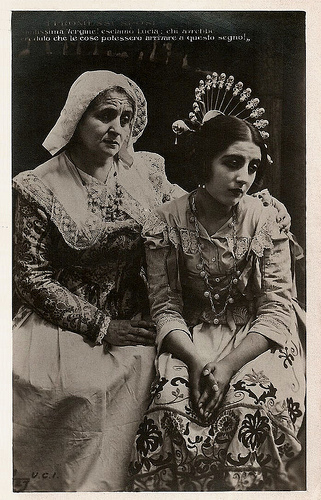
Italian postcard. Photo: Ida Carloni Talli (Agnese) and Emilia Vidali (Lucia) in I promessi sposi/The Betrothed (Mario Bonnard, 1922).
In arte
Ida Carloni Talli was born in Rome, Italy, in 1860.
She started as an amateur actress and became highly regarded among the companies of this kind. In 1887, she entered the legitimate theatre - or ‘in arte’ as they used to say - with the company of Giuseppe Pietriboni.
Subsequently, she became first actress at the Fava company, where she made her mark with La trilogia di Dorina by Gerolamo Rovetta.
She became company leader with Virgilio Talli – whose wife she became, assuming his name - and with Ettore Paladini for a couple of years, obtaining great success with audiences and critics with La parigina (La Parisienne) by Henry Becque (Milan, 1890) and in The Father by August Strindberg (Teatro Valle, Rome, 1893).
Her name is mentioned in the joint company Tovagliari-Carloni Talli-Pezzinga at which she collaborated with Baghetti Aristide and in 1899 she was at the company of Luigi Ferrati.
She was an admired interpreter both in drama and comedy, working with major companies, such as Andò-Leigheb, Emanuel, Garavaglia, and Ruggeri-Borelli.
Subsequently she withdrew from the theatre and taught for years at the School of Eleonora Duse at the Accademia di Santa Cecilia in Rome. Among her many pupils were Anna Magnani and many other famous actresses.
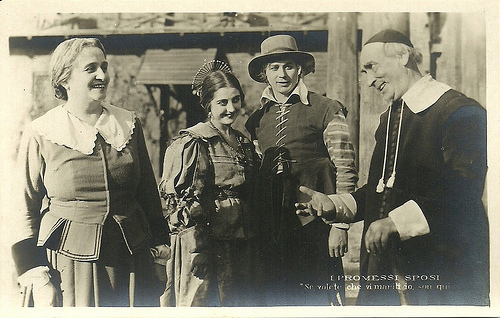
Italian postcard. Photo: Ida Carloni Talli (Agnese), Domenico Serra (Renzo), Emilia Vidali (Lucia) and Umberto Scalpellini (Don Abbondio) in I promesso sposi (Mario Bonnard, 1922), one of many adaptations of Alessandro Manzoni's classic novel. Caption: "If you want me to marry you, I'm here. The scene depicts the final scene of the story."
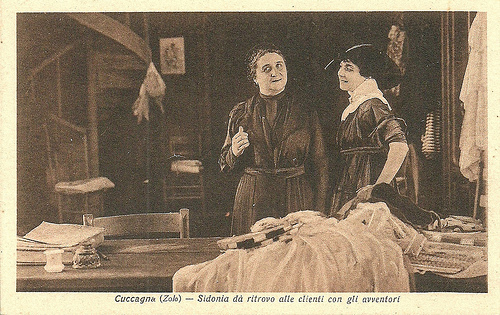
Italian postcard by IPA CT Duplex, no. 5078. Photo: Tiber Film, Roma. Publicity still for La cuccagna (Baldassarre Negroni, 1917). Caption: "Sidonia hosted meetings between her female and her male customers." La cuccagna was an adaptation of Emile Zola's La curée. Renata/Renée ( Hesperia ) is the second wife of the cunning and wealthy Saccard, who married young Renata for her money. She though develops an affair with Saccard's son Max/Massimo ( Alberto Collo ). Saccard's sister Sidonia/Sidonie Rougon (Carloni Talli) is a professional matchmaker between men and women with financial or amorous interests. She covers this secret profession with a trade in lace. It is she who arranges the marriage of her brother and Renée.
Noble and austere mothers
Ida Carloni Talli was also highly active in the Italian silent cinema. From 1912, she acted in subordinate and character parts, in 92 silent films, specializing mainly in the roles of noble and austere mothers.
In the early 1910s she acted in Cines in shorts like Anna Maria (1912), epic films like Quo vadis? (Enrico Guazzoni, 1913) and Marcantonio e Cleopatra/Antony and Cleopatra (Enrico Guazzoni, 1913), and the drama I due macchinisti (Enrique Santos, 1913).
Between 1912 and 1915, Carloni Talli was one of the regular supporting but also leading actresses in Cines shorts and features, together with other regulars like Leda Gys , Alberto Collo , Ignazio Lupi , Augusto Mastripietri and Amleto Novelli .
From 1913 she also acted at the Celio company, affiliated with Cines. She acted in films with Francesca Bertini such as Niní Verbena (1913), L’onestà che uccide (1914) and Rose e spine (1914).
In 1915 Carloni Talli moved to Tiber Film for many films with Hesperia and Maria Jacobini but also some with Lina Cavalieri , Lina Millefleurs, Diomira Jacobini and Diana Karenne .
She occasionally acted at the competing company of Caesar Film for films like Il capestro degli Asburgo ( Gustavo Serena , 1915) starring Francesca Bertini
In the mid-1910s Carloni Talli acted in many diva films, e.g. La signora dalle camelie/The Lady of the Camellias (Baldassarre Negroni, 1915), L’aigrette (Baldassarre Negroni, 1917) and La cuccagna (Baldassarre Negroni, 1917) starring Hesperia , and Come le foglie (Gennaro Righelli, 1916), starring Maria Jacobini .
She also played in the war propaganda films Cicueracchio ( Emilio Ghione, 1915) and Guglielmo Oberdan, martire di Trieste ( Emilio Ghione , 1916), and also had a part in Ghione’s crime serial I topi grigi (1918).
In the early 1920s, Carloni Talli acted at Fert Film in films with Maria Jacobini in Amore rosso (1921), La preda (1921), and Cainà (1922).
She also acted as Agnese in I promessi sposi/The Betrothed (Mario Bonnard, 1923) starring Domenico Serra and Emilia Vidali , and as the Mother Superior in the American production The White Sister (Henry King, 1923) starring Lilian Gish and shot on location in Italy.
Her last film was Consuelita (Roberto Roberti, 1925), starring Francesca Bertini.
Ida Carloni Talli died in Milan, Italy, in 1940.
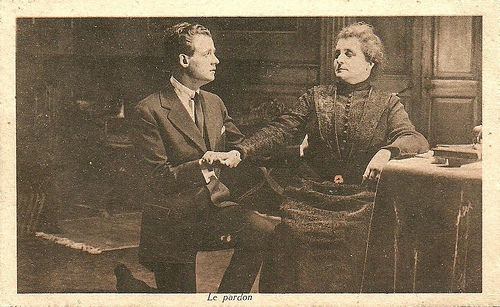
Italian postcard by IPA CT Duplex, no. 5105. Photo: Tiber Film, Roma. This is probably a publicity still of Tullio Carminati and Ida Carloni-Talli in L'aigrette (Baldassarre Negroni, 1917) (misspelled by IMDb as L'aiglette). This silent Italian film is an adaptation of a stage play by Dario Niccodemi. Ida Carolini Talli plays the countess of Saint-Servant, who has raised her son Enrico ( Tullio Carminati ) to be proud of his name and title, and to cherish honour and virtue, symbolised by the feather of her aigrette. In reality the countess is hunted by creditors, the castle is falling apart. Enrico falls in love with Susanne Leblanc ( Hesperia ), wife of banker, and in return she loads him with money in order to restore the castle. Her husband Claudio ( André Habay ) is not so happy with this kind of charity...
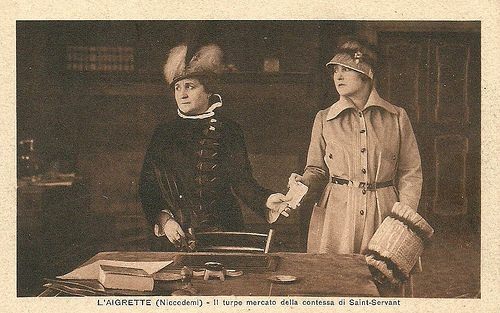
Italian postcard by IPA CT Duplex, no. 5105. Photo: Tiber Film, Roma. Hesperia and Ida Carloni Talli in L'aigrette (Baldassarre Negroni, 1917).
Sources: Wikipedia (Italian, English and Spanish) and .

Italian postcard. Photo: Ida Carloni Talli (Agnese) and Emilia Vidali (Lucia) in I promessi sposi/The Betrothed (Mario Bonnard, 1922).
In arte
Ida Carloni Talli was born in Rome, Italy, in 1860.
She started as an amateur actress and became highly regarded among the companies of this kind. In 1887, she entered the legitimate theatre - or ‘in arte’ as they used to say - with the company of Giuseppe Pietriboni.
Subsequently, she became first actress at the Fava company, where she made her mark with La trilogia di Dorina by Gerolamo Rovetta.
She became company leader with Virgilio Talli – whose wife she became, assuming his name - and with Ettore Paladini for a couple of years, obtaining great success with audiences and critics with La parigina (La Parisienne) by Henry Becque (Milan, 1890) and in The Father by August Strindberg (Teatro Valle, Rome, 1893).
Her name is mentioned in the joint company Tovagliari-Carloni Talli-Pezzinga at which she collaborated with Baghetti Aristide and in 1899 she was at the company of Luigi Ferrati.
She was an admired interpreter both in drama and comedy, working with major companies, such as Andò-Leigheb, Emanuel, Garavaglia, and Ruggeri-Borelli.
Subsequently she withdrew from the theatre and taught for years at the School of Eleonora Duse at the Accademia di Santa Cecilia in Rome. Among her many pupils were Anna Magnani and many other famous actresses.

Italian postcard. Photo: Ida Carloni Talli (Agnese), Domenico Serra (Renzo), Emilia Vidali (Lucia) and Umberto Scalpellini (Don Abbondio) in I promesso sposi (Mario Bonnard, 1922), one of many adaptations of Alessandro Manzoni's classic novel. Caption: "If you want me to marry you, I'm here. The scene depicts the final scene of the story."

Italian postcard by IPA CT Duplex, no. 5078. Photo: Tiber Film, Roma. Publicity still for La cuccagna (Baldassarre Negroni, 1917). Caption: "Sidonia hosted meetings between her female and her male customers." La cuccagna was an adaptation of Emile Zola's La curée. Renata/Renée ( Hesperia ) is the second wife of the cunning and wealthy Saccard, who married young Renata for her money. She though develops an affair with Saccard's son Max/Massimo ( Alberto Collo ). Saccard's sister Sidonia/Sidonie Rougon (Carloni Talli) is a professional matchmaker between men and women with financial or amorous interests. She covers this secret profession with a trade in lace. It is she who arranges the marriage of her brother and Renée.
Noble and austere mothers
Ida Carloni Talli was also highly active in the Italian silent cinema. From 1912, she acted in subordinate and character parts, in 92 silent films, specializing mainly in the roles of noble and austere mothers.
In the early 1910s she acted in Cines in shorts like Anna Maria (1912), epic films like Quo vadis? (Enrico Guazzoni, 1913) and Marcantonio e Cleopatra/Antony and Cleopatra (Enrico Guazzoni, 1913), and the drama I due macchinisti (Enrique Santos, 1913).
Between 1912 and 1915, Carloni Talli was one of the regular supporting but also leading actresses in Cines shorts and features, together with other regulars like Leda Gys , Alberto Collo , Ignazio Lupi , Augusto Mastripietri and Amleto Novelli .
From 1913 she also acted at the Celio company, affiliated with Cines. She acted in films with Francesca Bertini such as Niní Verbena (1913), L’onestà che uccide (1914) and Rose e spine (1914).
In 1915 Carloni Talli moved to Tiber Film for many films with Hesperia and Maria Jacobini but also some with Lina Cavalieri , Lina Millefleurs, Diomira Jacobini and Diana Karenne .
She occasionally acted at the competing company of Caesar Film for films like Il capestro degli Asburgo ( Gustavo Serena , 1915) starring Francesca Bertini
In the mid-1910s Carloni Talli acted in many diva films, e.g. La signora dalle camelie/The Lady of the Camellias (Baldassarre Negroni, 1915), L’aigrette (Baldassarre Negroni, 1917) and La cuccagna (Baldassarre Negroni, 1917) starring Hesperia , and Come le foglie (Gennaro Righelli, 1916), starring Maria Jacobini .
She also played in the war propaganda films Cicueracchio ( Emilio Ghione, 1915) and Guglielmo Oberdan, martire di Trieste ( Emilio Ghione , 1916), and also had a part in Ghione’s crime serial I topi grigi (1918).
In the early 1920s, Carloni Talli acted at Fert Film in films with Maria Jacobini in Amore rosso (1921), La preda (1921), and Cainà (1922).
She also acted as Agnese in I promessi sposi/The Betrothed (Mario Bonnard, 1923) starring Domenico Serra and Emilia Vidali , and as the Mother Superior in the American production The White Sister (Henry King, 1923) starring Lilian Gish and shot on location in Italy.
Her last film was Consuelita (Roberto Roberti, 1925), starring Francesca Bertini.
Ida Carloni Talli died in Milan, Italy, in 1940.

Italian postcard by IPA CT Duplex, no. 5105. Photo: Tiber Film, Roma. This is probably a publicity still of Tullio Carminati and Ida Carloni-Talli in L'aigrette (Baldassarre Negroni, 1917) (misspelled by IMDb as L'aiglette). This silent Italian film is an adaptation of a stage play by Dario Niccodemi. Ida Carolini Talli plays the countess of Saint-Servant, who has raised her son Enrico ( Tullio Carminati ) to be proud of his name and title, and to cherish honour and virtue, symbolised by the feather of her aigrette. In reality the countess is hunted by creditors, the castle is falling apart. Enrico falls in love with Susanne Leblanc ( Hesperia ), wife of banker, and in return she loads him with money in order to restore the castle. Her husband Claudio ( André Habay ) is not so happy with this kind of charity...

Italian postcard by IPA CT Duplex, no. 5105. Photo: Tiber Film, Roma. Hesperia and Ida Carloni Talli in L'aigrette (Baldassarre Negroni, 1917).
Sources: Wikipedia (Italian, English and Spanish) and .
Published on December 25, 2014 23:00
December 24, 2014
Françoise Dorléac
Chic and stylish French actress Françoise Dorléac (1942-1967) is best known as the elder sister of Catherine Deneuve with whom she sang and danced in the musical Les Demoiselles de Rochefort/The Young Girls of Rochefort (1967). Actually Françoise was the first to become a star in the 1960s with films by François Truffaut and Roman Polanski. She seemed set for international stardom when she suddenly died in a car accident at the age of 25.
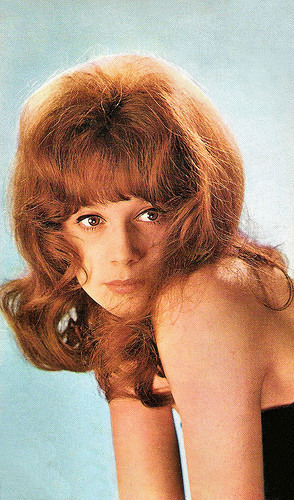
French postcard by E.D.U.G., offered by Corvisart, Epinal, no. 319. Photo: Sam Lévin.
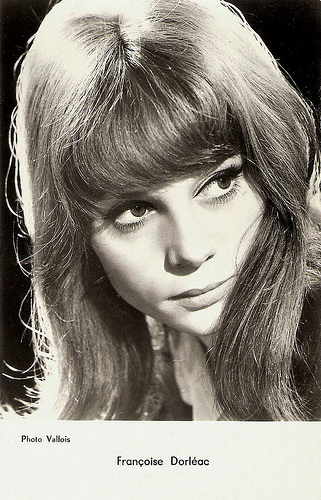
French postcard by Editions P.I., no. 1142. Photo: Vallois.
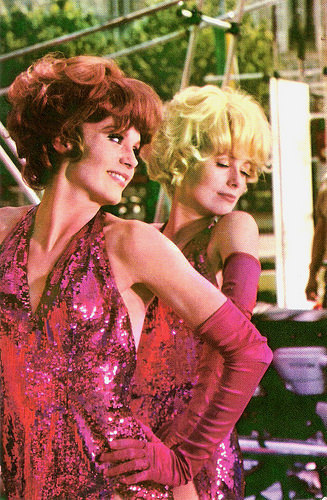
Romanian postcard by Casa Filmului Acin, no. 120. Photo: publicity still for Les Demoiselles de Rochefort/The Young Girls of Rochefort (Jacques Demy, 1967) with Catherine Deneuve .
Slim, Brunette Stunner
Françoise Dorléac was born in Paris in 1942. She was the daughter of screen actor Maurice Dorléac and Renée Deneuve, and the sister of Danielle Dorléac, Catherine Deneuve and Sylvie Dorléac.
Françoise first appeared on stage at the age of 10. She entered the film industry with the short film Mensonges (1957) and made her stage debut in Gigi by Colette at the Théâtre Antoine, Paris, in 1960. Meanwhile she studied at the Conservatoire d'Art Dramatique (1957-1961).
The slim, brunette stunner modeled for Christian Dior, and also graced a number of films including Arsène Lupin contre Arsène Lupin/Arsène Lupin Contra Arsène Lupin (Edouard Molinaro, 1962) opposite Jean-Pierre Cassel , with whom she was engaged for a while.
In 1964 she hit stardom with her roles in François Truffaut's melodrama La peau douce/The Soft Skin (1964) and the James Bond-like spy spoof L'homme de Rio/That Man from Rio (Philippe de Broca, 1964), in which she showed a razor-sharp comic timing.
At IMDb , reviewer Gary Brumburgh writes: “The two films showed the polar sides of Francoise's incredible allure and talent. In the former she played an airline stewardess who falls into a tragic affair with a married businessman (Jean Desailly) and in the latter she played a fun and flaky heroine opposite Jean-Paul Belmondo .”
She branched out in international productions such as Genghis Khan (Henry Levin, 1965) featuring Omar Sharif, and Where the Spies Are (Val Guest, 1965) with David Niven .
Another highlight was her part as the adulterous wife of Donald Pleasence in the black comedy Cul-de-sac (Roman Polanski, 1966).
Hal Erickson of AllMovie reviews: “Drawing upon two of Polanski's favorite themes-isolation and latent insanity--Cul de Sac actually improves upon each viewing, assuming that the viewer has the intestinal fortitude to sit through it once.”
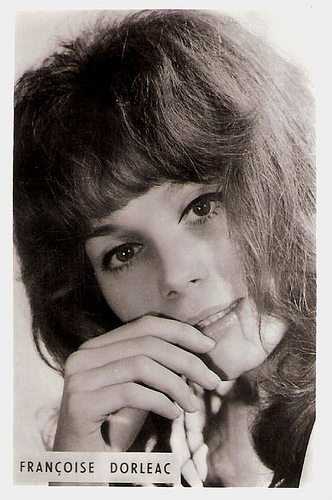
Small collectors card.
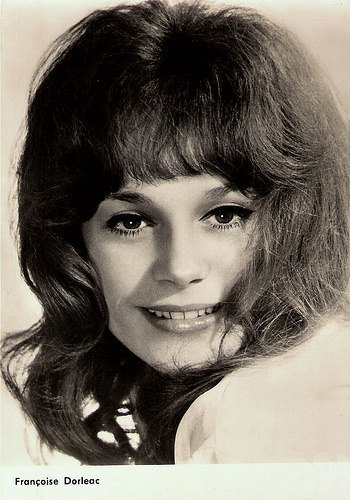
East-German postcard by VEB Progress Film-Vertrieb, Berlin.
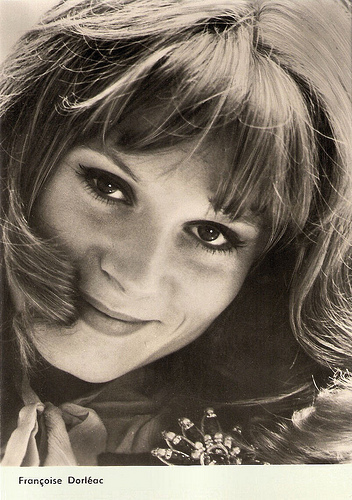
East-German postcard by VEB Progress Film-Vertrieb, Berlin, no. 2528, 1965. Retail price: 0,20 MDN.
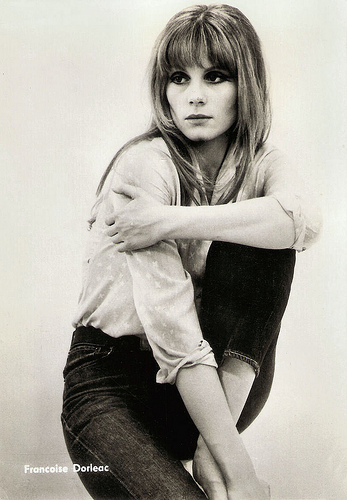
East-German postcard by VEB progress Film-Vertrieb, Berlin, no. 3292, 1968.
Unbridled Sense of Joie-de-vivre
While her sister Catherine was cool, calm, remote, and possessed with an edge of mystery about her, Françoise Dorléac proved a fun, carefree, outgoing presence both on and off camera. Known for her chic, stylish ways and almost unbridled sense of joie-de-vivre, she continued making strong marks.
Françoise and Catherine starred together in the musical Les Demoiselles de Rochefort/The Young Girls of Rochefort (Jacques Demy, 1967) opposite Gene Kelly and George Chakiris.
This colourful follow-up to Demy’s earlier success Les Parapluies de Cherbourg/The Umbrellas of Cherbourg (Jacques Demy, 1964) paid homage to the Hollywood musicals of the 1940s. Françoise and Catherine, who looked quite similar, played singing twins who dream about living in Paris.
The next film of the luminous Dorléac was the spy film Billion Dollar Brain (Ken Russell, 1967) starring Michael Caine as Harry Palmer.
Then her thriving career came to an abrupt and tragic halt when she suddenly died in a car accident. She had lost control of her sports car. The rented Renault crashed and burned on a roadway in Nice, France. She had been en route to Nice airport and was afraid of missing her flight. She had intended to fly to London to complete her work on Billion Dollar Brain, and to attend the British premiere of Les Demoiselles de Rochefort. Dorléac was seen struggling to get out of the burning car, but was unable to open the door. According to Wikipedia the police later identified her body only from the fragment of a check book, a diary and her driving license.
Gary Brumburgh writes: “Her early death at age 25 most certainly robbed the cinema of a tried and true talent and incomparably beautiful mademoiselle who showed every sign of taking Hollywood by storm, as Catherine later did.”
Françoise Dorléac and Catherine Deneuve in the delicious Les Demoiselles de Rochefort/The Young Girls of Rochefort (1967). Source: aya0021 (YouTube).
Françoise Dorléac and Donald Pleasance in Cul-de-Sac (Roman Polanski, 1965). Source: Klautenbogg (YouTube).
Hilarious sixties video clip: Françoise Dorléac sings Mario j'ai mal. Source: petiteteigne (YouTube).
Because we adore them: one more clip of Françoise Dorléac and Catherine Deneuve in Les Demoiselles de Rochefort/The Young Girls of Rochefort (1967). Source: Amatissta (YouTube).
Sources: (IMDb), Hal Erickson (AllMovie), Wikipedia and .

French postcard by E.D.U.G., offered by Corvisart, Epinal, no. 319. Photo: Sam Lévin.

French postcard by Editions P.I., no. 1142. Photo: Vallois.

Romanian postcard by Casa Filmului Acin, no. 120. Photo: publicity still for Les Demoiselles de Rochefort/The Young Girls of Rochefort (Jacques Demy, 1967) with Catherine Deneuve .
Slim, Brunette Stunner
Françoise Dorléac was born in Paris in 1942. She was the daughter of screen actor Maurice Dorléac and Renée Deneuve, and the sister of Danielle Dorléac, Catherine Deneuve and Sylvie Dorléac.
Françoise first appeared on stage at the age of 10. She entered the film industry with the short film Mensonges (1957) and made her stage debut in Gigi by Colette at the Théâtre Antoine, Paris, in 1960. Meanwhile she studied at the Conservatoire d'Art Dramatique (1957-1961).
The slim, brunette stunner modeled for Christian Dior, and also graced a number of films including Arsène Lupin contre Arsène Lupin/Arsène Lupin Contra Arsène Lupin (Edouard Molinaro, 1962) opposite Jean-Pierre Cassel , with whom she was engaged for a while.
In 1964 she hit stardom with her roles in François Truffaut's melodrama La peau douce/The Soft Skin (1964) and the James Bond-like spy spoof L'homme de Rio/That Man from Rio (Philippe de Broca, 1964), in which she showed a razor-sharp comic timing.
At IMDb , reviewer Gary Brumburgh writes: “The two films showed the polar sides of Francoise's incredible allure and talent. In the former she played an airline stewardess who falls into a tragic affair with a married businessman (Jean Desailly) and in the latter she played a fun and flaky heroine opposite Jean-Paul Belmondo .”
She branched out in international productions such as Genghis Khan (Henry Levin, 1965) featuring Omar Sharif, and Where the Spies Are (Val Guest, 1965) with David Niven .
Another highlight was her part as the adulterous wife of Donald Pleasence in the black comedy Cul-de-sac (Roman Polanski, 1966).
Hal Erickson of AllMovie reviews: “Drawing upon two of Polanski's favorite themes-isolation and latent insanity--Cul de Sac actually improves upon each viewing, assuming that the viewer has the intestinal fortitude to sit through it once.”

Small collectors card.

East-German postcard by VEB Progress Film-Vertrieb, Berlin.

East-German postcard by VEB Progress Film-Vertrieb, Berlin, no. 2528, 1965. Retail price: 0,20 MDN.

East-German postcard by VEB progress Film-Vertrieb, Berlin, no. 3292, 1968.
Unbridled Sense of Joie-de-vivre
While her sister Catherine was cool, calm, remote, and possessed with an edge of mystery about her, Françoise Dorléac proved a fun, carefree, outgoing presence both on and off camera. Known for her chic, stylish ways and almost unbridled sense of joie-de-vivre, she continued making strong marks.
Françoise and Catherine starred together in the musical Les Demoiselles de Rochefort/The Young Girls of Rochefort (Jacques Demy, 1967) opposite Gene Kelly and George Chakiris.
This colourful follow-up to Demy’s earlier success Les Parapluies de Cherbourg/The Umbrellas of Cherbourg (Jacques Demy, 1964) paid homage to the Hollywood musicals of the 1940s. Françoise and Catherine, who looked quite similar, played singing twins who dream about living in Paris.
The next film of the luminous Dorléac was the spy film Billion Dollar Brain (Ken Russell, 1967) starring Michael Caine as Harry Palmer.
Then her thriving career came to an abrupt and tragic halt when she suddenly died in a car accident. She had lost control of her sports car. The rented Renault crashed and burned on a roadway in Nice, France. She had been en route to Nice airport and was afraid of missing her flight. She had intended to fly to London to complete her work on Billion Dollar Brain, and to attend the British premiere of Les Demoiselles de Rochefort. Dorléac was seen struggling to get out of the burning car, but was unable to open the door. According to Wikipedia the police later identified her body only from the fragment of a check book, a diary and her driving license.
Gary Brumburgh writes: “Her early death at age 25 most certainly robbed the cinema of a tried and true talent and incomparably beautiful mademoiselle who showed every sign of taking Hollywood by storm, as Catherine later did.”
Françoise Dorléac and Catherine Deneuve in the delicious Les Demoiselles de Rochefort/The Young Girls of Rochefort (1967). Source: aya0021 (YouTube).
Françoise Dorléac and Donald Pleasance in Cul-de-Sac (Roman Polanski, 1965). Source: Klautenbogg (YouTube).
Hilarious sixties video clip: Françoise Dorléac sings Mario j'ai mal. Source: petiteteigne (YouTube).
Because we adore them: one more clip of Françoise Dorléac and Catherine Deneuve in Les Demoiselles de Rochefort/The Young Girls of Rochefort (1967). Source: Amatissta (YouTube).
Sources: (IMDb), Hal Erickson (AllMovie), Wikipedia and .
Published on December 24, 2014 22:00
December 23, 2014
Merry Christmas!
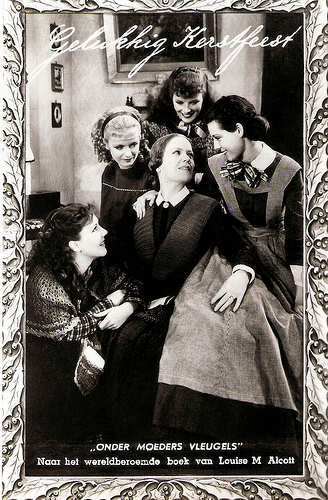
Dutch postcard by the Rialto Theatre, Amsterdam, 1934. Photo: Remaco Radio Picture. Publicity still for Little Women (George Cukor, 1933). In the picture are Katharine Hepburn, Joan Bennett, Frances Dee, Jean Parker and Spring Byington. The Dutch title of the film and the book by Louise M. Alcott is Onder moeders vleugels.
And Gelukkig kerstfeest is Dutch for:
Frohe Weihnachten! ¡Feliz Navidad! Joyeux Noël! Buon Natale! Sretan Božić! Καλά Χριστούγεννα! Boldog karácsonyt! Gleðileg jól! Nollaig Shona! Priecīgus Ziemassvētkus! Linksmų Kalėdų! Среќен Божиќ God jul! Wesołych Świąt! Feliz Natal! Crăciun fericit! С Рождеством Срећан Божић veselé Vianoce! Vesel božič! God Jul! Nadolig Llawen! Gëzuar Krishtlindjet! Eguberri! Merry Christmas!
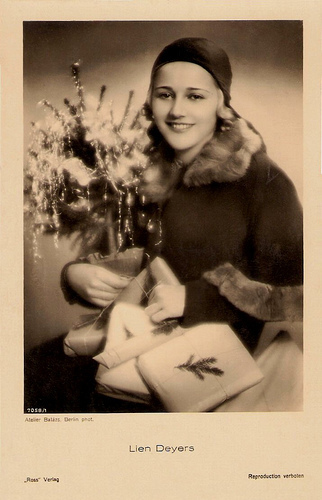
Lien Deyers . German postcard by Ross Verlag, no. 7058/1, 1932-1933. Photo: Atelier Balász, Berlin.
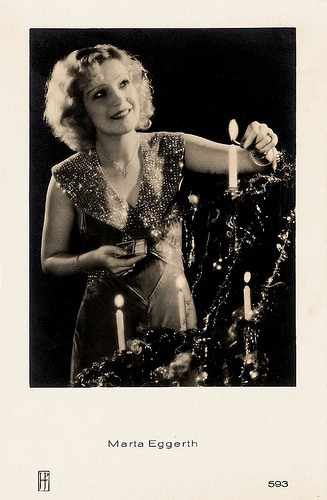
Marta Eggerth . Dutch postcard by JosPe, no. 593.
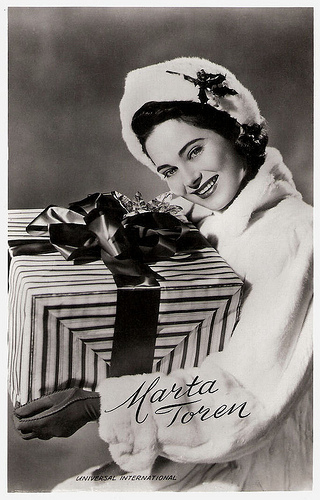
Marta Toren . Dutch postcard, no. 3374. Photo: Universal International / Fotoarchief Film en Toneel.
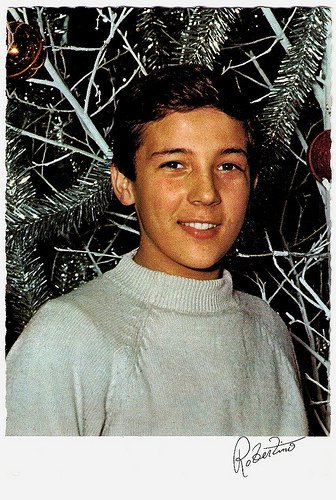
Robertino. French postcard by Editions Publistar, Marseille, no. 811. Photo: President.
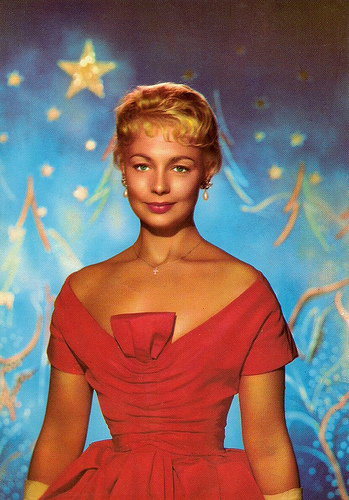
Dany Robin . French postcard by Editions P.I., Paris, no. 1004. Photo: Sam Lévin.
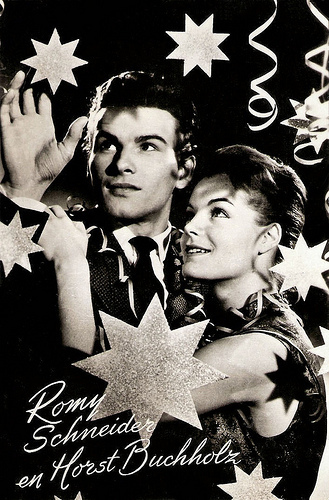
Romy Schneider & Horst Buchholz . Dutch postcard by Uitg. Takken, Utrecht, no. 3572.
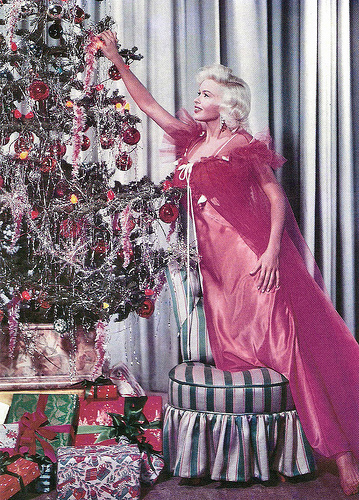
Jayne Mansfield. French postcard by Edition a la carte. Photo: Filmhistorisches Bildarchiv Peter W. Engelmeier.
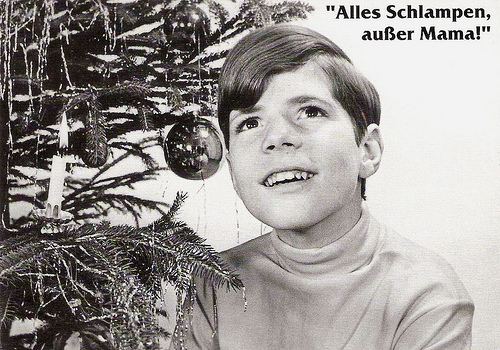
Heintje Simons . German postcard by Modern Times. Photo: Interfoto. Caption: Alles schlampen, ausser mama (All bitches, except mama).
Published on December 23, 2014 22:00
Paul van Yperen's Blog
- Paul van Yperen's profile
- 13 followers
Paul van Yperen isn't a Goodreads Author
(yet),
but they
do have a blog,
so here are some recent posts imported from
their feed.



